J Class Yachts For Sale (Sail)
- Upcoming Events
- AMYA J CLASS History
- Stuff for Sale
- Construction Videos

Building a J Class Model
By john hanks iii.
Now you may be wondering what is involved in building a model of a J Class yacht. I will give you an idea of what is involved in getting your J model in the water.
To begin with, let me say that you will need to do some scratch building to get your J model completed, regardless which yacht you choose to model. The scratch building will involve the deck, the rig, and probably the hardware associated with the mast, boom and rigging. With that said, you will need to decide which yacht you would like to model. In the full size J Yachts there was a definite advantage associated with which hull was in the water, but with the models, it appears that any of the J designs will make a good fast sailing model, if it is built correctly. So your decision should be driven by your personal preference for a particular boat. Once you decide which yacht you would like to model you will need to either buy a fiberglass hull or get the drawings for your chosen hull. There are hull line drawings available in the proper scale for all of the J's as well as some deck plans. You can get line drawings from several of the maritime museums, such as the Mystic Seaport Museum.
The amount of time that you will spend on building your model will vary with your building ability, whether you start with a fiberglass hull and how much detail you want to put on your model. Should you decide to scratch build the entire model with a lot of detail, you should plan on spending about 500 to 550 hours building your model. If you begin with a fiberglass hull, subtract about 150 hours, if you do not want to detail your model, deduct about another 100 hours. The cost of materials will be about $800 to $900 if you decide to completely scratch build your model.
I will begin the actual building process with a plank-on-frame hull. You can skip these steps if you start with a fiberglass hull. The process for completing the remainder of the model will be the same from that point on.
To begin the building process, you will need to get your drawings ready by extending each frame to a “waterline” that is above the deck line on the drawing. This new “waterline” will be the part of the frame that rests on the building board. The new “waterline” gives you a flat plane so that all of the frames are referenced to the building board surface, while allowing the arc of the sheer at the deck line to maintain its shape. Your modified drawing should show the hull shape, the shape of the deck beams, and the building board surface.
You will begin the building process by building a building board. The easiest way that I have found to do this is to buy an 8 foot long 4”x6” and mount it at a convenient building height on 2”x4” legs. You will need to make sure that the 4”x6” plank is straight and true and that it will stay that way through out the building process, as this will determine the trueness of your model.
Mark a centerline on your building board and then mark all of the station locations on the centerline. You will then need to draw a line perpendicular to the centerline at each of the station locations. You will next attach small blocks (approximately 1-1/2 x 1-1/2 x ¾ inch) to the building board on the centerline and aligned with the perpendicular station lines. The blocks need to be placed so that the frames that will be glued to these blocks will be centered on the perpendiculars.
The next step will be to cut out the frames that will form the hull. For this step you will need to keep in mind the difference between the line drawings for a metal hull versus a wooden hull. The drawings for a metal hull show the frames to the outside of the plating and for a wooden hull, they are to the outside of the framing, not the hull planking. This will make a difference in your model, as all of the Js were metal boats, and if you draw your frames to the lines, your model will be oversized by the thickness of your planking.
I use 1/8 inch Luan plywood for the frames. The plywood comes in a 4’x8’ sheet and I can get all 28 to 30 frames from one sheet of plywood. The frame patterns are cut from your drawing, and each frame pattern is traced on the wood. With careful placement you should have no trouble getting all of the frames traced onto the plywood. You will need to draw the cutouts for the keel, inwales and king plank in the frame tracings. The centers of the framed are also cut out so that you end up with a ring of wood that is about ¾ inch from the outside to the inside of the frame.
When I cut my frames I do not try to cut on the line that I have drawn; I am not that good with the saw. I leave a little wood, about a 1/16 inch next to the line and sand the frame to the final shape. I find that this makes it much easier to control the accuracy of the frame shape. Once all of the frames are cut and notched for the keel and inwales, they are glued to the blocks on the building board. At this point you should be able to sight down the frames and get a good idea of the shape of your hull.
With the frames glued in place, you are now ready to install the keel and the inwales. I like to use ¼ inch birch plywood for the keel and 1/4x1/4 inch square for the inwales. The inwales can be cut from the same material that you will use for the planking. The hull framing is very limber at this point but it becomes very ridged once the keel and inwales are in place.
The hull is now ready for planking. I have used pine, bass, aspen, spruce and alder for planking. All work well. The availability and price of the material is what determines which material I use. When I built my first J some 30 years ago, clear pine in 8 foot lengths was plentiful and inexpensive. Since then, it has become hard to find and very expensive. As a result I have used other woods that were available, hence the bass, aspen, spruce and alder. The planking material is cut into strips that are about 5/32 inch thick and 3/8 inch wide. This is a nice working size, as the planks are limber enough to form to the hull without the need for spiling (tapering), wetting, or steaming them. You will start the planking at the first frame and end at the last. The 2 to 3 inches of hull that remain at the ends will be filled with solid wood blocks shaped to the dimensions of the hull. Begin planking your hull at the sheer and work to the keel. Each side of the hull will require about 50 to 60 planks. Remember that you will need to alternate sides of the hull as you plank so that you keep the stresses equal on both sides of the hull, thus preventing distortion in the hull.
You will need to change direction of the planking when you get to the bilge area of the hull. The planking will take on an increased twist towards the stern that will prevent the planks from laying fair. The planks will tell you when you have reached this point, usually about 15 to 20 planks up on the hull. To overcome this you will need to lay a plank in a straight line along the hull so that it lays flat between the areas where the existing planking meets the keel. This will leave a lens shaped gap of about 4 or 5 inches between this plank and the existing planking at the middle of the hull. Fill this area by planking from the new plank that you laid down to the existing planking. Once you have completed that step, then continue to plank the rest of the hull. When you have finished your planking, you are ready to attach the bow and stern blocks, shape them, and sand the entire hull to get it ready for fiber glassing.
I like to build the rudder next and fit it to the hull. I build the rudder as I would build an airplane control surface, with a leading edge spar, three ribs, and a trailing edge. The framework is then covered with 1/32 inch plywood. The square tube that accepts the 5/32 inch brass rod rudder shaft is installed in the leading edge as well as the pivot pin at the bottom of the rudder. The hull is drilled and the rudder log is installed and the rudder is fitted in place. Once the rudder is fitted and works well, the hull is fiber glassed using a single layer of 6 ounce cloth and three to four coats of resin. Each coat of resin is sanded before the next coat is applied. When the sanding is complete you will have a smooth and fair hull that will look great when it is painted. The hull is now ready to be removed form the building board. At this time, you should also have a stand built and ready to accept the hull.
Once the hull is off of the building board, it is time to seal the inside with epoxy and install the mechanical workings in the hull as well as install any reinforcements that are needed, such as at the chain plates, mast step, and sheet exits. From this point on, the building process is the same for the fiberglass hulls once you have the deck beams in place. This is also the time to lay out the hatch openings. When laying out the hatch openings you want to keep them as small as possible and still be able to do any work inside the hull that is necessary. Nothing is more frustrating than to find out that you cannot reach some part of your equipment once the deck is in place, so be sure that you can work on and remove and replace all of the fittings, winches, ballast, etc., through the hatch(s) that you have framed in your deck.
Building the deck is the next big step in getting your J ready to sail. There are several different ways to build your deck, and your decision on how much scale detail you want on your model will drive part of that process. If you want a slick deck with no scale detail, then a simple plywood deck will do. The 1/8 inch plywood will be more than adequate for the job and can be finished so that you have a very good looking wooden deck on your model.
Another option is to build a plank deck that represents the deck on the full size yacht. If this is your preference, then you begin by cutting the deck planking to the same dimensions as the hull planking. I cut my planks to a length of 15 inches so that I have scale 20 foot planks. To simulate the deck caulking, I use black construction paper glued between the planks. Once you have the planking cut, you will need to lay the king plank down the center of the deck and the water way planks down each side of the hull. All of the Js had the planking run parallel to the edge of the hull, so you will need to begin laying your deck from the edge of the hull, and work to the center. The paper between the planks helps the glue, thin CA, flow and form a good bond at the seam. From this point on you just continue your planking until the deck is completely covered. As you build your deck you will need to cut your planking at the hatches so you will have access to the inside of the hull when you have finished your planking.
When the deck planking is complete, you will sand the whole deck and get it ready for finishing. At this point, you should have a great looking model.
Again your decision on the amount of detail that you want on your model will determine your next step. If you opt for a scale appearance, by this time you will need to make the cabins, deckhouses, winches, cleats, and anything else that goes on the deck.
The hull is now ready for finishing. I use non-water-based, clear gloss, polyurethane on the deck, cabins, and spars and automotive acrylic enamel for the color on the hull. These make very nice durable finishes which should last many years on your model. I chose to use polyurethane because it does not yellow like varnish does as it ages. This is a personal choice driven by how you would like your deck to look as it ages.
At this point you will have to ballast your model. I have found that the easiest time to do this is after the model is painted and has the scale waterline in place. Place your model in a swimming pool or other suitable tank, and place the lead in the hull until the hull sits on the waterline that is painted on the hull. You will need about 60+ pounds of lead in a manageable form, about 5 pound pigs, for this exercise. Once the lead has been placed in the hull and the proper trim established, you will need to note where the lead is in the hull and the amount at each location. You can then remove the lead from the hull and using your notes, make molds for the ballast so that it fits into the hull cavities.
The next step is building your rig. The masts for the J models will be anywhere from 8 to 91/2 feet tall, depending on which boat you are building and how you lay out the sail plan. For support, the mast will need at least two sets of spreaders with accompanying side stays, and a diamond stay. I have used both aluminum and wood to make J masts. The last mast that I built was made from spruce and was 109 inches tall, with a tear drop cross section that measured about 1-1/4 x ¾ inches. The mast was tapered in its top 3 feet and had a bolt rope slot cut in it used to attach the main sail to the mast. The mast was made from two pieces of spruce that were glued together on the centerline with the grain in each piece set so that any warps canceled each other out. The result was a stiff spar that weighed about 1-1/2 pounds ready to step on the deck Extruded aluminum masts are also available in lengths up to 10 feet, from Ludwig Manufacturing. These masts have a bolt rope slot molded in them and are both light, about 1 pound for a 10 foot piece, and stiff.
The main boom and jib club were both made from spruce. The jib club was about 33 inches long and 1x1/2 inch in cross section and tapered to 1/2 x1/2 inch at both ends. The main boom was about 45 inches long and was about 1 inch from top to bottom with a scale cross section that resembled an old wine jug. These shapes were made for a model of Rainbow.
The gooseneck attachment was made for a piece of ¼ inch thick aluminum plate and secured in a slot cut into the base of the mast. The gooseneck and boom vang pivot on a single stainless-steel rod, (welding rod) about 3 inches long. The boom can be removed from the mast by simply pulling the pivot pin; then the gooseneck and vang are released. The sail can then be slid down out of the bolt-rope slot and rolled for storage.
This is a quick overview of the building process that is needed to build a model J boat.
Below is a list of most of the materials that were used.
2 – 1”x8”x8’ pine, aspen, bass or other suitable wood that can be cut into 5/32”x3/8” strips for hull and deck planking
1 – 4’x8’x18” plywood used for hull framing, 2 if you are using one for the deck
1 – 1’x4’x1/4” five ply birch plywood for the keel
1 – 1’x2’x1/32” plywood used for the rudder sheeting
1 – 1”x4”x8’ spruce for the mast and booms (optional if you are using an aluminum mast)
4 – ¼”x12”x.030” brass strap used for chain plates, mast, and boom fittings
1 – 1/8”x3’ stainless steel welding rod used for gooseneck pivot and spreader stubs in the mast
1 – 1’x6”x1/4” aluminum plate used for the gooseneck and vang fitting (use only if you are scratch building the fittings
1 – 5/32”x12” brass round tube used for spreader bases
1 – 3/16”x12” brass rod used for the rudder shaft
1 – 7/32”x12” brass round tube used for rudder log
1 – 3/16’x12’ square brass tube used for the rudder shaft socket in the rudder
60+ pounds of lead used for ballast
4 – 8oz bottles of thin CA used for planking the hull and deck as well as general construction
1 – 2oz bottle of medium CA for general construction
32oz of 30 minute or longer set epoxy used to seal the hull interior
1 – 10’x50” 6 oz fiberglass cloth used to cover the outside of the hull
2 – Quart cans of polyester resin with catalyst used with the fiberglass cloth
6 to 8 – 2” disposable brushes used to apply polyester resin
8 – Turnbuckles used for the side stays, boom vang and diamond stay
36 – 1-72x 1” stainless steel machine screws with nuts and washers used for various attachments
90’ – 60 pound test nylon coated stainless steel fishing leader with swages used for the standing rigging
8 – Single blocks used for back stay, winch arm, up haul and rudder control
1 – Spool of 40 to 60 pound test braided Dacron line for the sheets
12 – Bowsies for various rigging adjustments
Reference Information
Reference book: Enterprise to Endeavour by Ian Dear, ISBN 1-57409-091-7
This covers most of what you would need to build your J model. I did not mention the wood or brass that I used to make the scale detail, as most of it was obtained as scrap from a cabinet shop and salvage yard. Some additional things that you will need are a radio (at least 2 channels), a quarter scale servo for the rudder, and a sail winch, either arm or drum with about 3,000 inch ounces of pulling power. You would also need to order your sails from your favorite sail maker.
I hope that this answers most of your questions about what it takes to build a model of a J Class yacht. By the way the process described above applies to scratch building any R/C model sail boat, the only difference is the scale of the project. Good luck with your building project

AMYA J CLASS
1330 North Andrew Drive, Kuna, Idaho 83634, United States
Copyright © 2022 AMYA J CLASS - All Rights Reserved.

J Class Class
| Clubs | Members | Boats |
|---|---|---|
| 5 | 67 | 151 |
| - for Sail Manufacturers, |
Description
- 0 £ 0
Refine Products
Gpb price range.
- 1 > 200 (3)
- 201 > 500 (9)
Display Model, Kits, RC
- Display Model (19)
Product Difficulty
Product hull type, product r/c compatible, product scale, vessel types.
- Classic sailing boat (6)
- J class yacht (13)
Manufacturers
J class yacht models.
Showing 1–12 of 19 results

America’s Cup Columbia Model Ship (Standard Range) – AM (AS076F)

Bristol Yacht Model Ship – OMH (Y096)

Columbia Half Hull – GN (HH008P)

Columbia Yacht L – OMH (Y155)

Endeavour Frame hull (Standard Range) – GN

Endeavour Half Hull – GN (HH005P)

Endeavour Half Hull – GN (HH005W-60)

Endeavour Model Yacht (Standard Range) – GN

Endeavour Model Yacht Black / White (Standard Range) – AM (AS155)

Endeavour Model Yacht Red/White (Standard Range) – AM (AS154)

J-Yacht ‘Rainbow’ 1934 Model (Standard Range) – AM (AS152)

J-Yacht ‘Ranger’ 1937 Model (Standard Range) – AM (AS150)
Information.
- Delivery & Packaging

- Cookie Consent
- Secure Payment
- Legal Notice
- Terms & Conditions

Follow us to keep up-to-date using our social networks

www.rcyachts.com
Builder of champions, header content region, insert text, image or banner ads here, or just delete this text and leave this area blank.
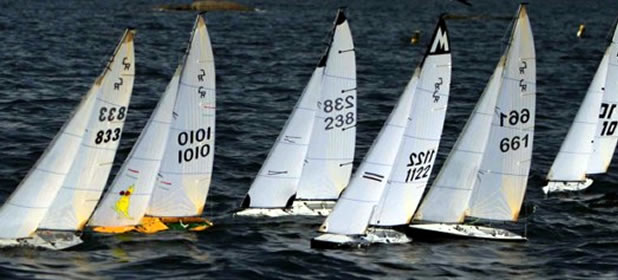
1/25 (36") Scale America's Cup high performance model sailboat
5ft Replica of the 1962 Americas Cup 12 Meter
45" Scale Model of the Olympic Star Boat
J Class Boat-Shamrock V
1/16 (8'-10')Scale Replica of the 1930's America's Cup Class Yacht
RMG Sail Winches
High Performance sail control winches

- Create as many news links as you need. News links are simple bullet lists.
ALL of our boats are PROUDLY

Click on the following logos to get further information on RC Sailboats
| IOM | |||||
Chesapeake Performance Models is the Manufacturer, Distributor and builder of the CR-914, EC12 Meter, J Class, Santa Barbara and Star 45 Radio Control model Sailboats. We now offer IOM rig building, commissioning, measuring and optimization serivces.
IOM Region 2 Championships Aug 23-25
Results - photos, cpm race week 2024 registration is closed who is coming, cr914 national championships 2023 j boat down the river race 2023 ec12 annapolis regatta 2023, 2022 cpm race week held sept 10-18 in the annapolis md area was a huge sucess and we hope you were able to attend. check out judy bonanno's amazing 2020 and 2022 race week photos .
Great Article in Spinsheet Magazines Jan issue.
Take a look.

Certified Manufacturer of EC12 Meter, S/B Star45, S/B and J Boat Hulls, Decks, Rudders & Ballasts
The custom Shamrock V J Boat Maiden sail
YouTube Video
Taken with a RC gimbaled GoPro Camera
Some great video shots!!!
Custom Paint and Graphics Fabrication and Builds to any Stage of Completion for all Classes
US SERVICE CENTER FOR THE RMG SAIL WINCH
Our email address is [email protected] Telephone: CPM Shop Phone 410-604-3907 Hours: Monday to Friday 9:30am to 6:30pm (EST)
Web Templates from i3dTHEMES.com
This is where you would add your text, images, or advertising banner

Copyright © 2021. Chesapeake Performance Models LLC. All Rights Reserved..
ages of sail
- About Us / FAQs
- How To Build Ships
JavaScript seems to be disabled in your browser. You must have JavaScript enabled in your browser to utilize the functionality of this website.
Recently added item(s) ×
You have no items in your shopping cart.
- My Wishlist
- Amati Model Ship Kits & Tools /
- America's Cup /
Endeavour w/ Tools - Wooden Hull (Amati, 1:80)
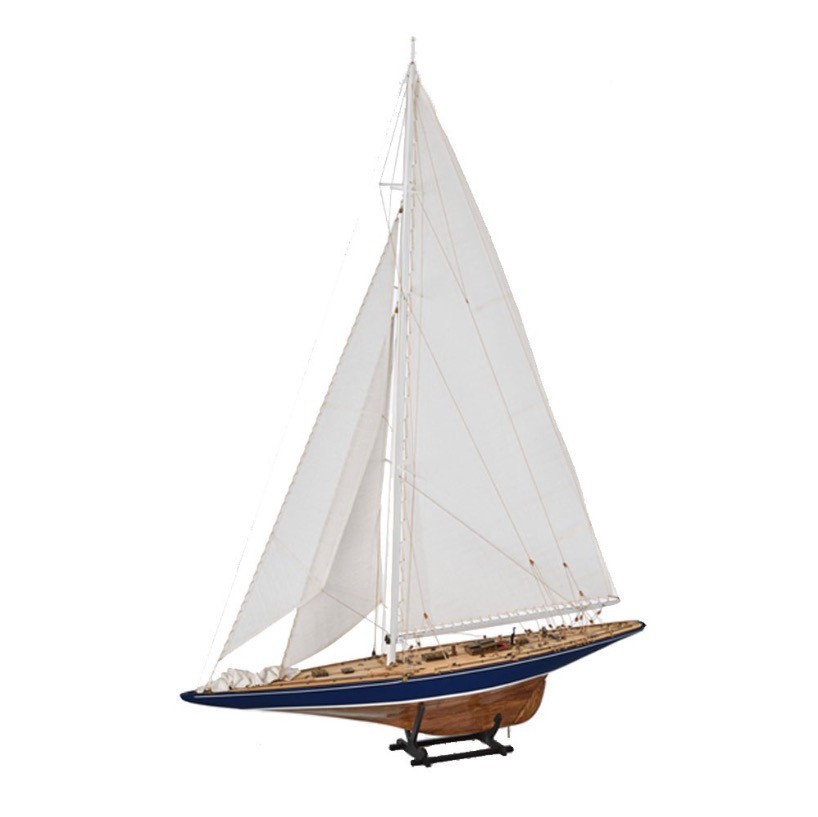
Availability: In stock
Endeavour J Class with Tools - Amati Wooden Kit
Part #AM1700/10
Scale 1:80 - Total length cm. 48 (18.9") - Height cm. 70 (27.6")
- Add to Wishlist
- | Add to Compare
- Email to a Friend
- Share Facebook
- Share on Twitter
Related Products
Check items to add to the cart or select all

Combo Set #1 - Endeavour - Wooden Hull
Endeavour J Class with Tools - Amati AM1700/10
The yacht Endeavour staked a claim on the America's Cup, winning the first two races. The third regatta was bound to be the most exciting. Fate played an unkind trick to Sir Thoms Sopwith, who failed and thus couldn't win the America's Cup.
Wooden model ship kit features plank-on-frame construction with laser cut keel, frames and deck; double planking in basswood and mahogany; metal and wooden fittings; cloth sails; wooden detailed mast; brass photoetched parts; plans and detailed instructions
Also includes a selection of model building tools.
Be the first to review this product
Product Tags
Use spaces to separate tags. Use single quotes (') for phrases.
- Search Terms
- Advanced Search
- Orders and Returns
Signup for news and special offers!
Welcome Aboard!
You have successfully joined our crew better known as subscriber list.

© 2024 ages of sail

Occasional ruminations, experimentations, and observations on the art and nonsense of building wooden radio control sailboats. Thanks for visiting!
Search This Blog
America's cup yacht constellation from 1964.

Post a Comment
Popular posts from this blog, iom sailboat stand, iom rig box (iom sail box) plans, iom alignment and measuring jig (updated), a wooden "alternative" iom rc sailboat.
Setting up and tuning the J class
Setting up and tuning your J Class model with Bermuda rig.
Introduction
The Nottingham 48 and the 60 are well designed models which in a good state of trim should be elegant, rapid and predictable on the water and a very satisfying model to sail. The underwater profile will resist the weed that is becoming a feature of summer sailing and which can be so frustrating for skippers of yachts will finned keels and separate rudders and the relatively shallow draft adds to the models versatility.
The model is fairly forgiving of poor sail trim but setting up the model correctly will add greatly to the pleasure of sailing it. Setting up a yacht and trimming it for the prevailing wind conditions is the subject of lengthy and protracted writing and my intention here is not to replicate these missives but to create a simple guide to how to get the most out of your model. For some this guide may be too simple but I make no apologies and hope that most readers will find the guide of use.
Basic principles.
The sails operate as two wings and are subject to the same rules of aerodynamics as an aircraft but unlike an aircraft the aerofoil shape of a sail can be altered to suit the wind conditions. These alterations are referred to as “tuning” the rig. There are two objectives in tuning the rig, to obtain maximum speed and also maximum control and the two objectives achieved together will get you round a course in the shortest time.
The 48 inch model is available with three rigs, A, B and C. The A rig has the biggest sail area and is cut to suit light winds. The B rig has a slightly smaller sail area and is cut to suit stronger winds whilst the C rig is often referred to as a “storm” rig. The operating parameters of each rig will overlap so that an A rig can be detuned as wind speed increases and the B rig can be tuned for more power as wind speed decreases. The most versatile rig for day to day use is the B rig as it can be tuned for most conditions. I don’t have a C rig as if the wind speed dictates the use of this rig it’ s probably time to go to the pub but serious racing skippers will have a C rig.
The sail is not just a flat sheet but consists of a number of panels. Each panel is cut and joined so that it will naturally try to adopt an aerofoil shape. Further, the luff of the sail is cut with a curve or arc so that when it lies against a straight mast the sail will adopt even more shape.
Initial setting up.
Place the mast in the mast tube and fix the shrouds and backstay. Attach the jib swivel so that the sails are relaxed with no tension in the shrouds and only slight tension in the backstay and jibstay. Back off the kicker on the mainsail boom and ensure the leech line is loose. Stand back and look at the rig. The leech of the jib should lie parallel to the mast and as close to the mast as possible and the mainsail boom should lie roughly parallel to the deck. At this stage ensure that the foot of the mainsail and jib is fitted a close to their respective booms as possible and that the jib boom is fitted as close to the deck as possible.
Increase the tension in the rig first by tensioning the jibstay and then with the backstay so that the top of the mast is firmly located against fore and aft movement. Nip up the shrouds so there is just sufficient tension to secure the mast against sideways movement. Nothing should be “tight” at this stage.
Adjust the foot of the jib and mainsail using the clew adjuster so that the foot is flat (but not tight) and adjust the luff of the jib and mainsail the same ensuring that there are no wrinkles in the sails. This should make a good starting point for tuning and you should ensure that there is sufficient room to adjust on all of the adjusters.
Adjust the kicker or vang so that the end of the mainsail boom is able to move up and down about 10mm. The kicker changes the twist in the leech of the mainsail.
Adjust the foot of the mainsail and jib so that the foot adopts a slight curve. Add a little tension to the leech line on the jib so that this too has a slight shape. The general rule of thumb is that the curve in the leech of the jib should match the twist in the leech of the mainsail
In general terms, you will want to achieve a “full” shape in both sails for light winds and as the wind speed increases you will add tension to the rig to “flatten” the sails.
Note that any adjustment you make to one part of the rig will require additional adjustments to the other elements of the rig.
Adjustments.
Backstay. This has the biggest effect on the rig overall. Tension in the backstay is transferred through the mast, creating a bend in the mast, tension is transferred down the jibstay to the tack of the jib, along the jib boom which pivots on the jib swivel and so puts tension into the leech of the jib.
As you add tension to the backstay you will see the shape of the mainsail flatten as the mast curves forward in the middle. As the top of the mast moves aft the end of the mainsail boom will drop so add tension using a mixture of tension in the jibstay and tension in the backstay. If the mainsail boom drops too far it risks dipping into the water as the yacht heels in the wind which will upset the shape of the mainsail.
Kicker. Increasing the movement in the back of the boom will increase the twist in the mainsail. This will allow wind to spill out of the top of the mainsail, depowering the top part of the sail and improving control in windy conditions.
Main sail luff tension. As you increase the tension in the backstay the tension in the luff will reduce. Use the adjuster to add tension. The luff shouldn’t be tight, but should be tight enough to keep a straight edge whilst still being able to swing around the mast on the luff rings.
Clew adjustment. (Both the mainsail and the jib) Moving the adjuster forward will put more shape in the foot of the sail and also the lower part of the sail. More shape will give you more power but also increase the drag created by the sail. Less shape will reduce power for better control in higher winds. Try to keep a similar shape in the foot of both mainsail and jib.
Jib luff tension. As with the Mainsail, the tension should be sufficient to maintain a good shape in the sail without wrinkles but not so tight that it creates more tension than the jibstay.
Leech line. As you put more tension into the rig you will flatten the leech of the jib and reduce its power. Use the leech line to take the tension out of the leech and add shape to match the shape of the mainsail.
Shrouds. The main purpose of the shrouds is to stabilise the mast. Putting too much tension into the shrouds will emphasise the curve in the mast and distort the shape of the mainsail. You should add just sufficient tension to stabilise the mast. Mounting the shrouds further back on the chainplate will reduce curve that will be put into the mast by the power of the wind, thus retaining the original shape you created when the model was at rest. A second set of shrouds fitted at the spreaders will add more support to the mast as it comes under pressure from the power of the sail as wind speed increases.
Jib slot adjustment. The jib boom should be opened up by adjusting the loose sheeting so that the end of the boom points toward the chainplate on the deck as a start. The jib slot serves to accelerate air through the slot and over the mainsail and this increased airflow over the mainsail improves the efficiency of the sail and the speed of the model. If your slot is too narrow the forward part of the mainsail will distort, and loose its aerofoil shape, (known as backing) but if too wide the slot will have little effect. Adjustment on the 48 is something of a compromise but the 60 has a separate servo to adjust the slot on the water. At slower speeds with reduced airflow the slot is narrowed to increase the velocity of the air travelling through it. As the hull speed increases the mainsail will start to “back” under the pressure of both velocity of the air and the increased volume so the slot can be opened improving the efficiency of the mainsail
Mainsail boom adjustment. The mainsail sheet should not be tight when sheeted in. I adjust the end of the boom so that when sheeted in its about 10 to 15mm off the centre line. As a guide, I start by looking at the back of the mainsail which should be pointing in a direction so that the airflow from the sail is directed aft, along a line parallel to the centre line of the hull
Weather helm and lee helm. This term refers to the tendency for the model to point up into the wind and stall, (weather helm) or point away from the wind (lee helm) especially when travelling into the wind. The model is designed to be “balanced” ie, that it should track a straight line without radical movements to the rudder which creates drag and reduces speed. If you experience weather helm this can be solved by increasing the power in the jib/reducing the power in the main and if you have lee helm vice versa. Lee and weather helm is a response in the hull to the sails not being tuned to act together.
Tuning the sails should sort both lee and weather helm but if not you can change the weight distribution in the hull. The centre of effort of the rig is designed to be forward of the centre of lateral resistance of the hull. As the yacht heels in the water the curvature of the hull acts as a rudder and tries to steer the hull in a direction opposite to the heel, into the wind. Placing the centre of effort forward overcomes the steering effect of the hull but it’s a fine calculation and will be slightly different for each model. The answer to weather helm is to move the centre of effort further forward by powering up the jib or depowering the main, (preferred) or, moving the entire rig forward, or alternatively moving the centre of lateral resistance aft. This is achieved by adding weight to the back of the keel which puts more stern in the water and takes some bow out of the water.
If you have lee helm which cannot be solved by tuning you can add weight to the forward part of the ballast which will put more bow in the water and take some stern out of the water, moving the centre of lateral resistance forward.
This is a radical solution and before you embark on changing the weight distribution I suggest you talk to me first as the tuning of the rig is likely to be the prime suspect of lee and weather helm issues.
You may find that as the model is accelerating (eg, having just rounded a buoy and sailing into the wind) and is heeling in the wind, that the hull tries to turn around the mast. This is often confused with weather helm but issues relating to weather helm and lee helm are better assessed when the hull is up to speed. This perceived weather helm is caused by the sails accelerating in an environment where there is little resistance and the hull, subject to the resistance of the water, has yet to catch up with momentum of the sails. This causes the hull to continue turning into the wind even if you have applied opposite rudder.
There are a number of solutions, all to do with how you sail the model, not necessarily tuning. The first is to straighten the rudder when half way round the buoy and let the hull do the rest (a straight rudder creates less resistance and the hull will accelerate more quickly). The second is to operate the sails with less vigour, bringing the sails to their final position for the run more slowly. Or a mixture of the two above. Maximum speed and maximum control are achieved by making slower, measured and progressive movements to the controls.

Sailing Yacht and Sailboat Models
Classic Yacht Under Sail
1900’s America’s Cup Defender ” Yacht Columbia”
Shamrock V Racing via marsemfim
J Class Lionheart Sailboat Onboard
J Class Yacht “Lionheart”
J Class Wooden Yacht Model Replica “Lionheart”
1937 America’s Cup J Yacht Ranger Wooden Sailboat Model
The J-class yacht Ranger won the 1937 America’s Cup, defeating 4-0 the Endeavour II of Britain, raced at Newport, Rhode Island. It would be the last time huge J-class yachts would race in the America’s Cup.
Vintage Photo Shamrock V off Rhode Island J Yacht, America’s Cup
1895 Yacht Iverna at Full Sail
In 1890, Iverna represented a new design of great racing cutter – a handsome yacht with her distinctive fiddle or cutter bow and undercut stern. Commissioned by John Jameson (of the Irish whisky family), designed by Alexander Richardson and built by J G Fay in Southampton, she was 98ft. in length – 118ft. with her bowsprit – with a beam of 18ft. and a sail area of 8157 sq. ft.
J Class Yachts Rainbow and Vesheda Under Sails source
Shamrock V Yacht via jclassyachts
Shamrock was originally owned by Sir Thomas Lipton, the owner of the English grocery chain ‘ LIPTON ’, and famous for his import of Lipton Tea from India.
Shamrock V was built in 1930 for Sir Thomas’s fifth and last America’s Cup challenge. Designed by Nicholson, she was the first British yacht to be built to the new J Class Rule and is the only remaining J to have been built in wood. After launch she was continually upgraded with changes to hull shape and rudder. The rig was also modified to create the most effective racing sail plan but she was no match for the faster US design “Enterprise”.
Sir Thomas made all five of his America’s Cup challenges as a member of Royal Ulster Yacht Club, a club that continues to this day to have a strong involvement with The Cup.
Shamrock V was sold in 1933 to Sir Richard Fairey (Fairey Aviation) who again was a keen yachtsman who campaigned it in company of two new steel J’s built during 1933 – 1934, Velsheda and Endeavour. After World War II, Italian owner Mario Crespi installed the elegant bird’s-eye maple interior.
America’s Cup Shamrock Wooden Sailboat Model
Sails and Rigging Wooden Mast
1934 J-Class Yacht Rainbow Model
J Class Yacht Velsheda Model
Designed by Charles Nicholson and built by Camper & Nicholson in 1933 for Mr W.L. Stephenson, Owner of Woolworth chain of shops, she was built in 1933 at Gosport. She was Nicholson’s second design for a J Class and Stephenson’s second big yacht.
“Velsheda” was named after Stephenson’s three daughters, Velma, Sheila and Daphne. She raced with the greatest names in classic yachting including “Britannia”, “Endeavour” and “Shamrock” between 1933 and 1936.
In her second season she won more than 40 races and achieved an outstanding record of success at Regatta’s from Southend to Dartmouth. Other venues included Torbay, Swanage and of course the Solent, all under the control of the very famous Captain Mountfield.
The permanent racing crew at that time was probably around 16 men and this would have been augmented to around 30 for racing. When not required for sail changes, spare crew were moved to below decks.
1966 Queen Elizabeth with birthday gift for Prince Andrew age 6. Sailboat was a gift via flickriver
J Class Yacht Velsheda via source
Schooner Atlantic source
On the Deck at the Helm photo by Terry Hilbert
Atlantic Schooner Ship Model
Commissioned by New York Yacht Club member Wilson Marshall, the Atlantic was launched in 1903. William Gardner, one of America’s foremost designers of large yachts, designed her. From the moment Atlantic went to sea, it was clear that she was an exceptionally fast and beautiful schooner. When a yacht in 1903 hits twenty knots during her sea trials, she is a promising yacht, but even then nobody could imagine two years later this yacht would set a record that would stand unmatched for almost a century.
Sailing Yacht Atlantic – Photo credit to Kees Stuip
1934 America’s Cup Race Yacht Rainbow source
J Class Yacht Endeavour via jclassyachts
Endeavour was commissioned by Sir T.O.M. Sopwith to challenge for the America’s Cup in 1934. Having prepared his campaign in Shamrock V, Sopwith was keen to ensure that this yacht was the most advanced design possible. With his experience designing aircraft Sopwith applied aviation technology to Endeavour’s rig and winches and spared nothing to make her the finest vessel of her day. From launching in 1934 she continued her preparation by competing against Shamrock V (then owned by Sir Richard Fairey) and the newly launched Velsheda (owned by W.L Stephenson).
The Yacht Magic
America’s Cup Rainbow Yacht Model
Yacht Rainbow via yachtworld
Olympic Class Racer Dragon Model Ship
Vanderbilt at helm of RAINBOW, New York Yacht Club Cruise,1934 source mysticseaport
Concours Racing
Bluenose Schooner source
Bluenose Schooner Model Ship
Classic Yacht on the Deck
Classic Sailing Yacht
Classic Yacht J Class Endeavour photo Yoshi Yabe
America’s Cup Sailboat Endeavour Fully Assembled Model Ship
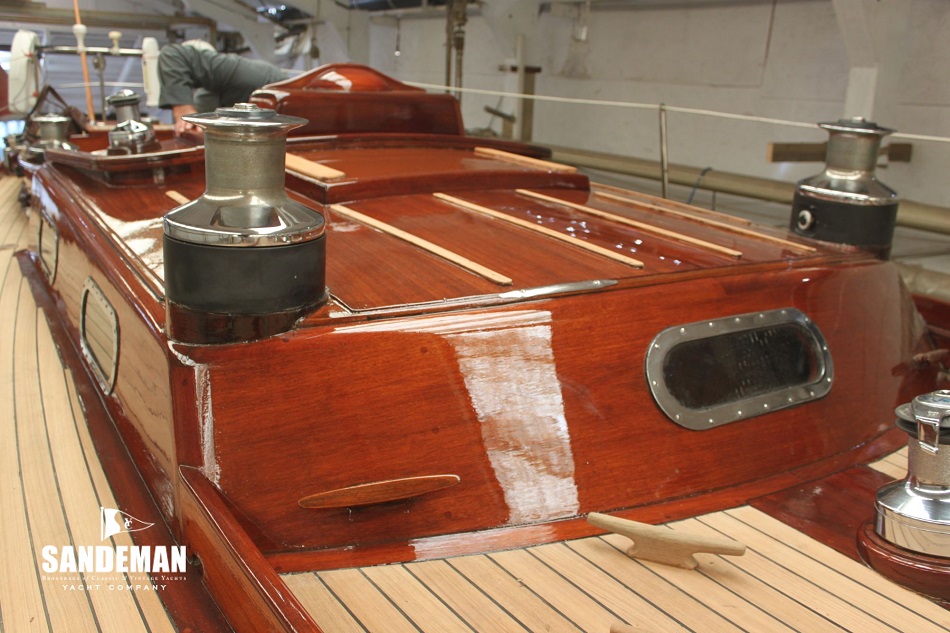
SPARKMAN & STEPHENS 40 FT SLOOP 1964 source
Sailing Schooner Under Sail source
Sailboat Love this Rigging source
Windjammer Schooner Heritage of Main schoonerheritage
the coast of Maine has been the foundation of the schooner’s design
Luxury Sailing Yacht SY Huckleberry source
Classic Sailing Yacht source
j class yacht enterprise

Originally built for Harold van der Bilt and designed by Starling Burges, Enterprise was the first J to win the America's Cup in 1930. She can be built in aluminium with an almost flush deck without deckhouses. Carbon hi-tech spars, a tall sail plan and an extensively optimised handicap will give this yacht an edge in certain conditions. All naval architecture work and interior design will be by our office. Contact us for more information.
LOA 38.7 m LWL 24.4 m Beam 6.7 m Draft 4.4 m Yard t.b.d. Year t.b.d.

Before the J Class yachts came into existence, yachts were designed to be bigger and bigger. The towering rigs of the Big Boat Class such as ‘ Lulworth ’ and ‘ Britannia ’ dwarfed all other yachts. The late 1920s heralded discussion and agreement of the Universal Rule. This new formula controlled the size and displacement of the new yachts, enabling them to be raced as evenly as possible. Almost immediately, designs were being commissioned for the new, massive ‘Bermudan rigs, with no bowsprits’.
The rule was based on ideas proposed by Nat Herreshoff allowing waterline length to be increased without sail area being restricted, as it had been under the International Rule. This was compensated by a larger displacement and so draught was limited to 15ft.
In 1929 Sir Thomas Lipton, owner of Lipton’s famous for his import of Lipton Tea from India, issued his fifth challenge to the Americans for the America’s Cup. He commissioned the build of the first J Class Yacht which signified the start of a new era in design evolution and racing. On each occasion he challenged for the America’s Cup as a member of the Royal Ulster Yacht Club in Northern Ireland. RUYC are still involved with The Cup – presenting the Royal Ulster Cup to the Club of the winning challenger.
The Universal Rule came into effect in 1930. The size of a yacht was determined (by waterline length) and this was shown as an alphabetical list. “J” signified yachts with a waterline length of between 75 to 87 feet. The addition of the new design Bermuda mast allowed the yachts to carry a huge sail plan. Nothing so large and ‘awesome’ had been built previously. The Americans had a distinct advantage over Britain in the 1930 America’s Cup. They had the money to build four J’s over Britain’s one, yet the British yacht, Shamrock V was a hot contender. She was designed by Nicholson and built at the family yard in 1930, and before she crossed the Atlantic to attend the Cup she had notched up more than 700 sea miles (1,296km), won 15 out of the 22 races she had entered and had been tweaked and tested to a high degree.
In answer to Lipton’s challenge of 1929 the Americans designed four J-Class yachts as possible defenders. Enterprise, Whirlwind, Yankee and Weetamoe were launched within a month of each other; Weetamoe and Enterprise from the Herreshoff yard and Yankee and Whirlwind from Lawley & Son’s yard in Bristol.
Whirlwind, the second J, was the most revolutionary of the four. Francis L Herreshoff had moved away from conventional yachts and designed a boat, which took the new rule to its extreme. Whirlwind combined many new ideas and Herreshoff experimented with hull shape and rig. She was the longest of the early J’s at 86ft on the waterline and remained so until Ranger and Endeavour II were built in 1937.

She was built of semi-composite construction (the other three American Js were built out of the highly expensive Tobin bronze), was double-ended and had a permanent backstay. Uffa Fox described her profile as: “Very pleasing to the eye, the stem sweeping down to the keel in a very sweet line, and to a man who, like myself, believes that a pointed stern is a logical ending for all vessels, her stern is a joy to behold.” He predicted, “If the Yacht Racing Rules govern well and wisely, we shall see Whirlwind racing 50 years hence. If they do not she will probably be cruising then.” But Whirlwind met an early demise. Her building was delayed as she didn’t meet Lloyd’s A1 scantling rules and she wasn’t chosen to be the 1930s defender. She was often out-performed when close hauled, her steering gear making her difficult to steer. She was eventually scrapped along with Enterprise in 1935. However, her unusual double-headsail rig was later adopted by the rest of the Js.
The third American J, Yankee, was the best all-rounder. At 84ft on the waterline and 125ft length overall, she was solidly made of Tobin bronze and was extremely well balanced. Designed by Frank Paine , Yankee had an almost straight sheerline and easy lines. She was a powerful contender for defender, but not fine-tuned enough to succeed. She did, however, take part in the 1934 America’s Cup trials and with alterations to her rig, to carry more sail, and bow, which was lengthened and made more of a V-shape, she then proved more successful, especially in light winds.
The fourth of the American J’s was Weetamoe, which was designed by Clinton Crane and was the narrowest of the early four. Despite claims that Yankee was the best all-rounder, Weetamoe is said to have been the closest rival to Enterprise to be the Cup defender. Charles Nedwick, in Ian Dear’s book Enterprise to Endeavour, describes Weetamoe as having a profile “that is practically a triangle, with a straight line from the after end of the waterline to the bottom of the keel and thence a line which is slightly convex, and then slightly concave to the forward end of the waterline.” In an attempt to better performance and make her less tender, her profile below the water was radically altered in 1934 with a new contour and bulb keel. The alterations failed and not long afterwards were reversed. In common with the other J’s, she had about 43ft of overhang and her hull, Nicholson opined, “was the best of all the US Js”.
When Shamrock V and Enterprise eventually met off Newport, Rhode Island, later that year, the two J’s were well matched in hull profile, but differed significantly in rig. Enterprise’s rigging was lighter, she had the Park Avenue boom, which was so advantageous to windward, and had lots of winches on board. Shamrock V meanwhile, was under-winched and hard work to sail. She has since, however, proved her success in that she is still sailing today.
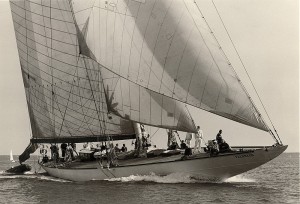
The sixth J-Class yacht to be built, and the second built on British soil was Velsheda . She was the only J not built as a contender for the America’s Cup. Her owner, WL Stephenson, who previously owned White Heather II, the 23-Metre converted to rate as a J-Class in 1930, had Velsheda built in steel in 1933 at the Camper & Nicholson yard. Velsheda was a great success. In 1935 she was significantly altered, her bow was snubbed around the waterline and her stern improved. The following season she won the King’s Cup at Cowes Week.
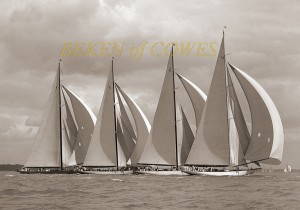
In 1934, Sopwith challenged for the America’s Cup. His challenger was Endeavour . She was Charles Nicholson’s third J-Class design and he said of her “She will have quite a normal hull… because I have thought it right to suppress possible experimental form, which would be most interesting to try out, but which I have to leave to American designers.” He did, however, produce the most beautiful J-Class and her rig was innovative.
Sopwith experimented with new running backstay strain gauges, which controlled the trim of the mast and used electronic windspeed and direction indicators. It has since been suggested that part of the reason for her failure in the Cup was due to all the gadgets on board. She was matched 83ft 3in on the waterline against Rainbow ’s 82ft. However, despite being thought to be the best challenger Britain has ever built, she did not win the Cup. Rainbow, which was considered the inferior boat, beat her by four races to two.

Rainbow was designed by W Starling Burgess and launched in 1934 from the Herreshoff yard where she was built in just 100 days. The J stepped a pear-shaped duralumin mast, designed to take the strain of the double-headed jib – first used on Whirlwind – and she was originally rigged with a Park Avenue boom. This was later removed because it was considered too heavy.
The UK Class was depressed with the death of King George V and scuttling of his yacht “Britannia” off the South of the Isle of Wight, in accordance with his will.
Of the American Js, Yankee was the only one to sail in British waters when she was bought by Gerald Lambert and crossed the Atlantic in 1935. She was scrapped in 1941. Enterprise and Whirlwind were both scrapped in America.
1937 saw the building of the last two J’s on both sides of the Atlantic. Both Ranger and Endeavour II took the waterline length to its extreme, measuring 87ft LWL . Ranger, the American boat, was built at Bath Ironworks in Maine and designed jointly by W Starling Burgess and Olin Stephens . It was a design combination, which produced the greatest J of the fleet – the ‘super J’ as she was later known. She was built, for the cost of the materials only, of flush riveted steel plating and soon after launching had an accident. The upper parts of her rod rigging which stayed her duralumin mast shook loose and her mast snapped “with a report like a cannon”.
Ranger’s success on the water was widespread. Of 37 starts she won 35. Owner-skipper Harold Vanderbilt described her as being “slower to turn and to pick up speed, but (she) held her way longer, and was perfectly balanced on the wind.” The challenger, Endeavour II, was designed by Nicholson again and built at the C&N yard. She too was steel, but flush-plated above and below the waterline. Sopwith towed her and Endeavour, plus an entourage of 100, to America where he worked on tuning her rig. Sadly, Ranger saw off the competition, easily winning four races, and dashing British hopes.
Although they became recognised the most beautiful yacht design in the world, only 10 J Class yachts were ever built – 6 in the USA and 4 in the UK. Most of these competed in trials for the America’s Cup, or competed in the Cup itself. Several existing large British yachts, ‘ Astra ’, ‘ Candida ’, ‘White Heather II’ and ‘Britannia’, the King’s yacht, were all converted to comply with the rule and raced alongside the J’s.
After the victory of Ranger over Endeavour II, Vanderbilt wondered whether the boat was so much faster than the competition that it might kill the class. History would show this was not the case as analysis of the Holm design shows that it would likely have been faster than Ranger.
1937 marked the end of an era – it was the last America’s Cup contest for 21 years and marked the end of Big Yacht racing. Shamrock V was sold to Mario Crespi, the Italian Senator and publisher, who converted her to a ketch rig and renamed her ‘Quadrifoglio’, with a literal translation giving her authentic name of ‘4 leaves’ in Italian. This was in accordance with an Italian law, which forbade foreign names.
Weetamoe was scrapped in this year, while at the end of the season Ranger was laid up, prior to being scrapped in 1941.
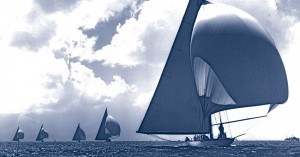
HANDLING THE J CLASS YACHTS IN THE 1930’s
The Skippers had to be experienced in racing and their skill on the race circuit became a matter of pride. These mighty craft had no engines and they had to be handled with great precision to get into and out of ports. Often their experience came from sailing all types of small craft, including fishing boats, during the winter months, when the J Class yachts were laid up. The permanent racing crew in the early days was probably around 16 men thou this may have been augmented to around 30 for racing. When not required for sail changes, spare crew were often moved to below decks.
With the incredible loads on the rigging and systems it was a constant concern that J Class masts could collapse in winds above a Force 3.
Sailing small boats in often inhospitable waters gave them the skills to manage their J Class yachts. The same is true today. Skippers have to deliver their yachts across Oceans, and compete around the race course, using their skills and all the technical advantages that are available today.
It is now clear that there was another J Class Yacht under development in 1937. Several years ago, drawings for a J-Class boat by Swedish naval architect Tore Holm were discovered by Fred Meyer, (Société Nautique de Genève – the Defender of the 32nd America’s Cup).
Now known as the Holm Project, this was to be a Swedish yacht with an innovative design. Many of the hull plates were made – and exist to this day. The project was put on hold prior to the outbreak of War in 1939 and was forgotten for more than 60 years. Endeavour and Endeavour II (K6) were laid up at Camper & Nicholson’s yard in Gosport, England.
Rainbow was scrapped. By the end of 1941, all the US yachts, which had been laid up were scrapped for their metal, with the last two being Yankee and Ranger. None survived. Yankee’s owner Gerard Lambert allegedly donated her scrap money from the yacht to Queen Mary to be used at her discretion in the London Hospital, in memory of the courtesies shown to Yankee by King George and the Queen herself.
Endeavour II was sold for scrap to Charles Kerridge Limited but her hulk remained until the late 1960s. Endeavour and Velsheda became houseboats in a mud berth on the River Hamble. This is where they stayed for more than 30 years, protected by the mud, which they had sunk into. Only Shamrock V was still sailing.
Endeavour II was broken up and scrapped in Southampton. Quadrifoglio (Shamrock V) had been hidden in Italy in a barn throughout the war years and following Crespi’s death in 1962 was sold to Piero Scanu, who saved her just two weeks before she was due to be broken up in Genoa.
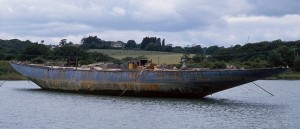
During the 1970s Endeavour’s hulk was sold for £10 and restoration was started.
Quadrifoglio (Shamrock V) arrived from Italy and was refitted at Camper & Nicholson’s yard where she had been built, supervised by Paolo Scanu the naval architect, and son of the owner.
The large holes in Endeavour’s hull were plugged and she was towed to the old seaplane base at Calshot Spit on the Solent to start restoration.
Terry Brabant rescued Velsheda from her Hamble mud berth and gave her enough of a refit to get her chartering and, occasionally, racing again in events like the annual Round the Island Race, hosted by the Island Sailing Club in Cowes. Despite being in rather poor condition she still acquitted herself well and looked magnificent from a distance. Swiss plans to restore her came to nought and the old racing yacht was eventually laid up afloat in Gosport. Elizabeth Meyer took on the challenge to continue with the rebuild of Endeavour at Calshot.
Quadrifoglio (Shamrock V) was purchased in 1986 by the Thomas Lipton Company, and given back her original name of Shamrock V, when she became the property of the Newport Museum of Yachting. Endeavour was towed from Calshot, to Cowes on the Isle of Wight to have her fittings and rigging fitted. She was then taken on a barge to the Royal Huisman Shipyard in Holland to continue and complete the rebuild.
Endeavour was relaunched in Holland. Endeavour and Shamrock V match raced each other over the Old America’s Cup course in Newport, Rhode Island in August.
Velsheda was purchased from a bankrupt C&N boatyard and brought to Southampton Yacht Services to start her rebuild. She was relaunched in 1998 and started her programme of racing and cruising around the World.
Velsheda, Shamrock V and Endeavour raced against each other in Antigua Classic Week.
The Owners met in England and formed the J Class Association to protect the interests of the Class, present and future. Class Rules were established for the construction of Replica Rebuilds from original plans. Shamrock V came out of a major refit at Pendennis in Falmouth under the supervision of the Dykstra office.

The first J Class Regatta is held in Christchurch Bay on England’s south coast over three days, followed by the Jubilee Regatta in Cowes.
Ranger replica was commissioned and construction started at Danish Yacht Shipyard.
Ranger was launched and started her racing programme.
Replicas of Endeavour II (Hanuman) and Ranger (Lionheart) are commissioned.
Replicas of Rainbow and Paine design (JH7) are commissioned.
Hanuman, replica of Endeavor II launched.
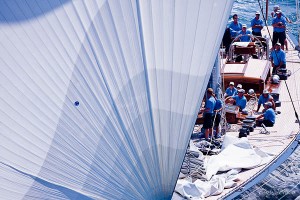
Lionheart launched.
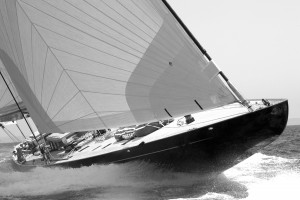
Rainbow launched. Cheveyo commissioned from Sparkman & Stephens / Spirit Yachts.

Information courtesy of the J Class Association
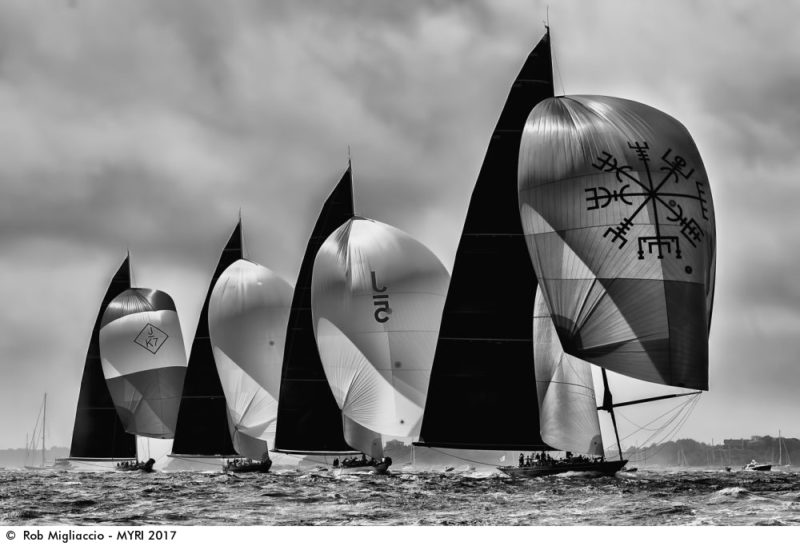
Svea, Velsheda and Topaz at the St Barths Bucket, 2018.
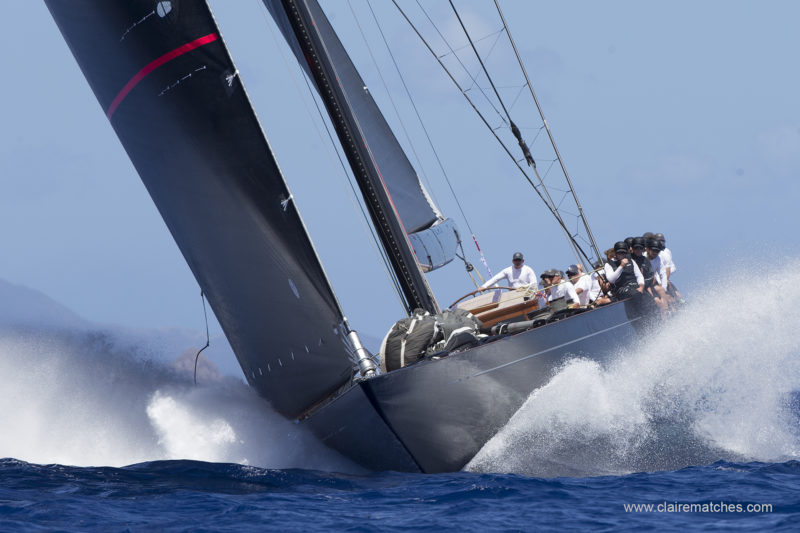
SHARE THIS:
- Yachts for Sale

Recently updated...

Write an Article
Covering news on classic yachting worldwide is a tall ask and with your input Classic Yacht Info can expose stories from your own back yard.
We are keen to hear about everything from local regattas and classic events to a local restoration or yachting adventure. Pictures are welcome and ideal for making the article more engaging.
With a site that has been created with the assistance of an international group of classic yacht enthusiasts we value your input and with your help we strive to make CYI more up-to-date and more informative than ever.
Please register and get in touch if you would like to contribute.

choose your language:
We’re passionate about Classic Yachts here at CYI, and we welcome submissions from all over the globe!
Captain, rigger, sail-maker or chef – if you’d like to write for CYI just let us know!
Email [email protected] to be set up as a Contributor, and share your Classic thoughts with the world.
ClassicYachtInfo.com has the largest database of classic yachts on the internet.
We’re continually working to keep it accurate and up-to-date, and we greatly appreciate contributions of any type. If you spot an error, or you have some information on a yacht and would like to contribute, please jump on in!
Don’t be shy…. Breeze on!
- Sell Your Yacht
BoatNews.com
America's Cup: the fabulous J Class epic, between excess and innovation
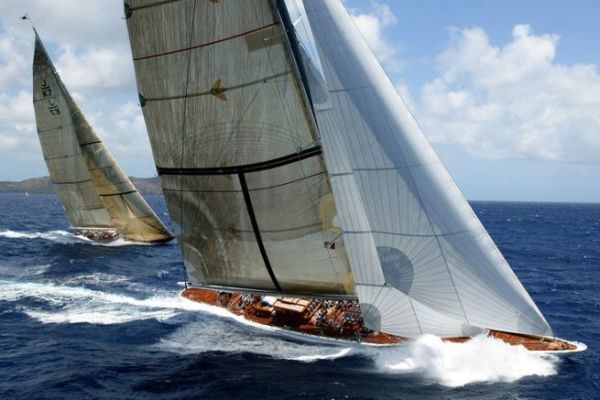
From 1930 to 1937, the America's Cup was contested on J-Classes, monstrous regatta yachts of almost 40 meters in length. Only ten J-Class yachts were ever built, but they left an indelible mark on the history of the Cup
The first regattas of the Cup in real time
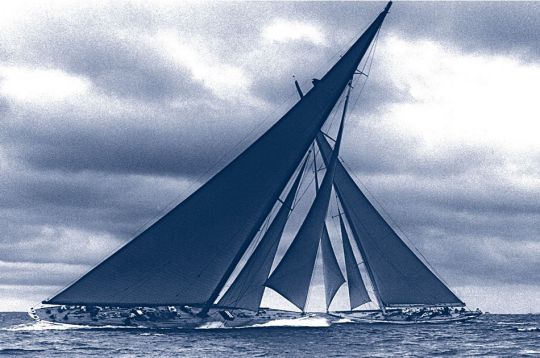
For the 1930 edition, the unions decided to adopt the "Class J", whose rating was to be fixed. For the first time in the history of the Cup, the competitors no longer ran in compensated time, but in real time. The first to cross the line is declared the winner! The Class J are defined according to the Universal Gauge , a rule published by the American architect Nathanael Herreshoff in 1903. The heavy gaff rigging was abandoned in favour of a Bermuda rig.
1930 : The little English thumb in front of a horde of Americans
For this 14th edition, the English challenger is building Shamrock V, a yacht of nearly 36 metres. With its wooden hull on a steel frame, its displacement exceeds 170 tons.
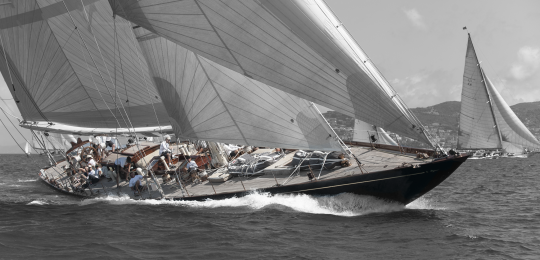
The Americans will present four Class J to face the representatives of the crown: Whirlwind, Resolute, Vanitie and Enterprise. The latter is the first racing yacht to be equipped with a duralumin mast, which gives her an undeniable advantage in close-to-wind conditions.
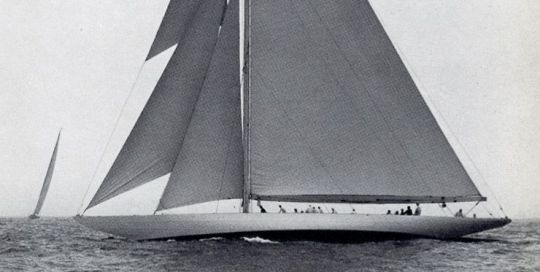
Enterprise is also the first J Class to be fitted with modern deck fittings, with nearly 23 winches on its deck plan. Victory is clear, as Enterprise won the Cup by 4-0 against Shamrock V. But this resounding victory did not allow it to escape deconstruction in 1935, just five years after its launch.
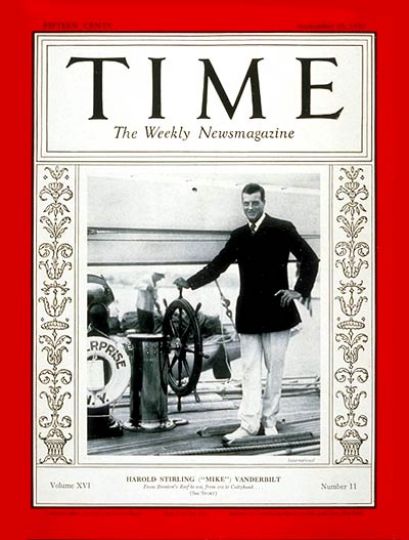
1934: a social movement upsets the prognosis
Financed by the industrial aviator Thomas Sopwith, the British members of the Yacht Club of Squadron decided to redouble their efforts and had Endeavour built, 39 m long and with a displacement of 143 tonnes.
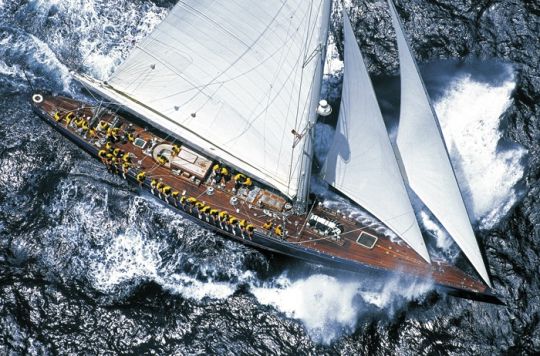
The sailboat is well born. The duel with Rainbow's Americans is shaping up to be a fierce one. The American defender has a heavier and slower Class J for the start phases. Its lively works have the particularity of being bronze sheets riveted on steel frames. Endeavour won the first two races. But financial problems put a strain on the confidence of the English crew , and some of them left the boat from the third regatta onwards. The deserters will be replaced by passionate, but nevertheless amateur sailors. Faced with a disparate and untrained English crew , the American won the next four regattas and won this 15th edition.
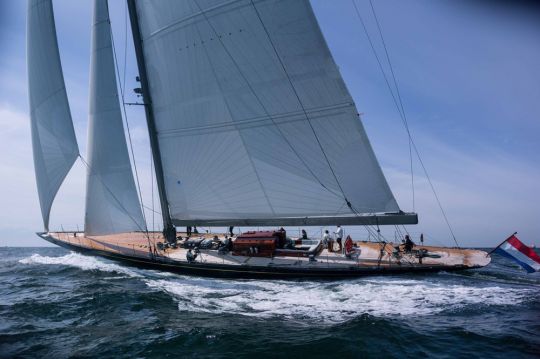
Because of the particular design of the live works, Rainbow turned out to be a mass of electrolysis and had to be scrapped in 1940.

1937: the last edition on Class J
For this 16th edition, the English challenger is exploiting the gauge in its last trenches. The British architect Charles Nicholson designed Endeavour II, with a maximum authorised length of 41.40 m.
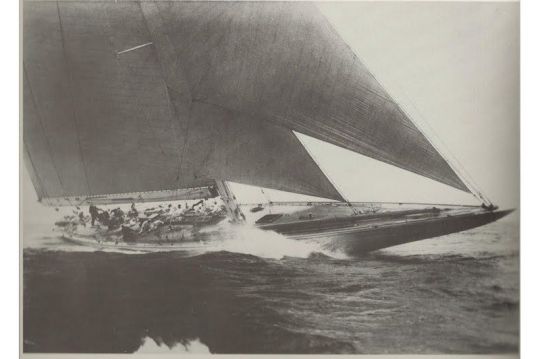
In the American camp, Harold S. Vanderbilt financed an expensive campaign of tank testing. Supervised by architect Oli Stephens, the construction of the Defender Ranger will take place at the Bath Iron Works in Maine. Harold S. Vanderbilt won his third Cup in a row, joining Charlie Barr as a three-time Cup winner.
Many innovations still present today
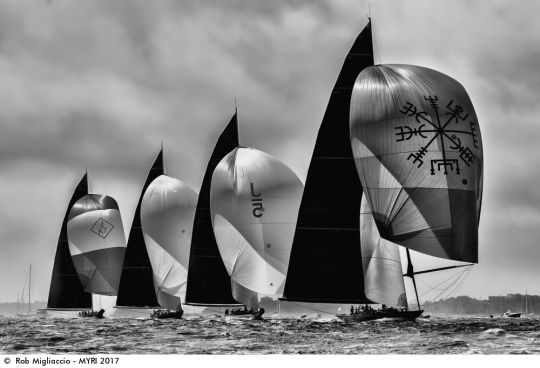
The many innovations tested on the J Class are still relevant today and some of them can be found on our contemporary yachts:
- guying in profiled rod
- boom and mast groove replacing wooden rings
- the multiplication of spreader stages to ensure better mast support
- electronic instrumentation, in particular the wind vane anemometer
- wide boom "Park Avenue"
- aluminium mast and standardization of genoa on tall ships
What happened to the Class Js?
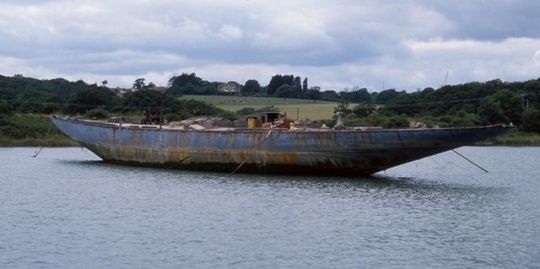
The Second World War put an end to the J-Class on the America's Cup . Only three of them survived the conflict. The others were stripped of their lead to join the war effort. After the war, the J-Class boats were considered too expensive and were replaced by the J-Class boats at the 12m JI on the Cup .
But a handful of wealthy skippers decided to bring these giants back to life and launched costly restoration projects in the 2000s. Because they had to cross the Atlantic to get to the regatta site, the British J Classes were better built than their American counterparts, and suffered less from the ravages of time.
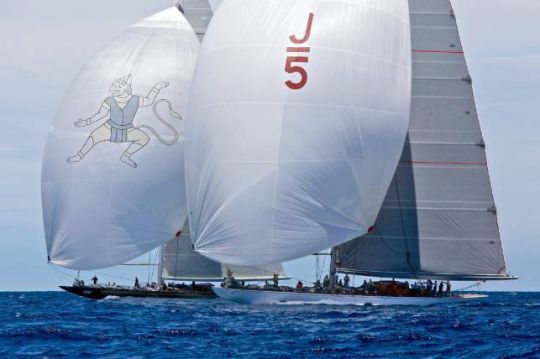
Shamrock V and Endeavour were thus saved from the mudflats in which they were rotting. The missing Class Js were replicated with the original measurements. To this day, nine J Classes continue to compete on a world circuit.
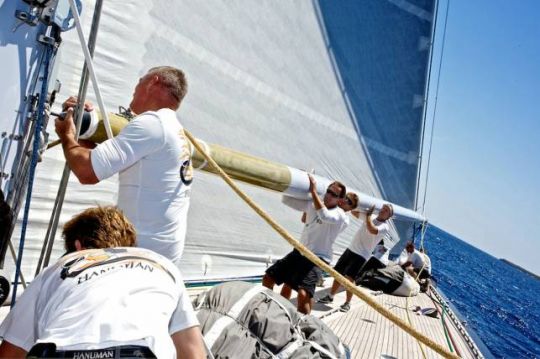
They have lost none of their excess and continue to turn heads. Eric Tabarly admitted that "when it comes to boats, I've never seen anything so beautiful. No one has ever contradicted him.
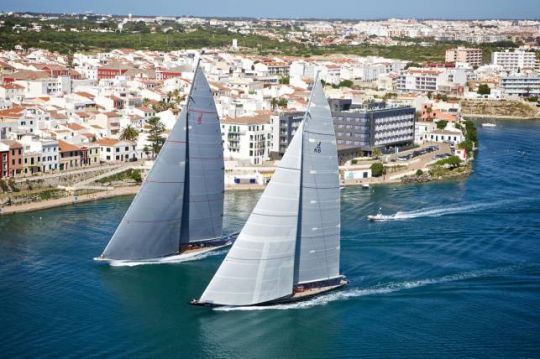
- Yachting World
- Digital Edition

J Class: the enduring appeal of the world’s most majestic yachts
- October 9, 2023
Only ten J Class yachts were built before the Second World War stopped the movement in its tracks, but in the last 20 years these magnificent sloops have made an incredible comeback. Why has the J Class remained irresistable? David Glenn explains.

One of the most awe-inspiring sights in modern yachting is the Spirit of Tradition fleet blasting off the start line at the Antigua Classic Yacht Regatta. It happens every year at the end of April. Chances are it will include at least two J Class yachts, hitting the line on the gun at full tilt, exploding through the cobalt blue Caribbean rollers at anything up to 12 knots as they charge upwind.
Watching Velsheda , Ranger , Shamrock V and Endeavour will bring a lump to your throat, such is the emotion generated by these beautifully proportioned 130ft racing machines with their carbon rigs driving 170 tonnes of steel, aluminium and teak towards the weather mark. It’s heady stuff.
Watching them is one thing; racing quite another matter. In 1999 I was aboard the rebuilt Velsheda , taking part in the Antigua Classic Regatta. I had a single task as part of a four-man team – to tend the forward starboard runner. Nothing else. “Let that go once we’ve tacked and the whole rig comes down,” warned skipper Simon Bolt, as another wall of water thundered down the leeward deck and tried to rip me from the winch.
Dressed in authentic off-white, one-piece cotton boiler-suits, which had to be worn with a stout belt “so there’s something to grab if you go overboard”, they were tough, adrenaline-filled days out. God knows what it was like up forward as massive spinnakers were peeled and headsails weighing a quarter of a tonne were wrestled to the needle-sharp foredeck as the bow buried itself into the back of yet another wave. Sometimes you daren’t look.
But with the race won or lost, back on the dock the feeling of elation, fuelled by being part of the 36-strong crew aboard one of these extraordinary yachts, triggered a high like no other. You knew you were playing a role, no matter how small, in a legendary story that began in 1930, was halted by World War II and then defied the pundits by opening another chapter 20 years ago. Today with five Js in commission, all in racing trim, and at least two more new examples about to be launched, the J Class phenomenon is back.
Why is the J Class so popular?
Why does a yacht with an arguably unexciting performance – they go upwind at 12 knots and downwind at 12 knots – costing £20 million to build and demanding eye-watering running costs, seem to be burgeoning during the worst recession since the class was born?

There is no single answer, but you only have to look back to the 1930s and the characters that owned and raced the Js on both sides of the Atlantic, sometimes for the America’s Cup , to understand why the class occupies a special place in yachting history. Underlying everything is the look of the J Class. It seems to transcend any change in yachting vogue, displaying a timeless line with outrageous overhangs and a proportion of hull to rig that is hard to better.
They possess true elegance. There is no doubt that captains of industry who want to flex their sporting muscle have been drawn to a class which only the very rich can afford and there are distinct parallels between J owners in the 1930s and those of the past 20 years. The difference is that in the 1930s owners liked to shout about their achievements and hogged the pages of national newspapers. Today, they are as quiet as mice.
Origins of the J Class
The J Class emerged in 1930 and marked a quantum leap in yachting technology, but comprised a hotchpotch of design altered over many years.

The J Class – so named because it was the letter allocated to its particular size by the Universal Rule to which the yachts were built (K and M Class yachts were, for example, shorter on the waterline) – emerged in 1930 and marked a quantum leap in yachting technology.
The so-called Big Class, which flourished in the UK in the 1920s, was impressive, but comprised a hotchpotch of design altered over many years. Yachts like King George V’s Britannia , built in 1893 as a gaff-rigged cutter but converted in the 1920s to Bermudan rig to rate as a J, Candida , Cambria , White Heather and schooners like Westward were even larger and more expensive to run. But as the greater efficiency of the Marconi or Bermudan rig became apparent their days were numbered.
One catalyst for the J Class itself was legendary grocer Sir Thomas Lipton’s final crack at challenging for the America’s Cup in 1931. He did so under the Universal Rule with the composite, wooden-planked, Charles E. Nicholson-design Shamrock V .
It was the 14th challenge since 1851 and the Americans, despite the withering effects of the Great Depression, reacted in dramatic fashion, organising their defence with four syndicates, each bulging with millionaires, putting forward separate Js: Enterprise , Whirlwind , Weetamoe and Yankee , which apart from Enterprise had already been launched.
Key to the American effort was the remarkable Harold Vanderbilt of the New York Yacht Club, who had inherited fabulous wealth from the family’s railroad companies, making him one of the country’s richest men.
Brought up on the family’s Idle Hour estate on Long Island Sound, he was a keen and accomplished sailor, and he used American technology and teamwork to build a far superior J in Enterprise. The defence completely overwhelmed Lipton’s effort. The British press castigated Lipton’s lack of preparedness and old-fashioned attitude. Vanderbilt, who among other things is credited with inventing contract bridge, left no stone unturned. “Mr. Harold Vanderbilt does not exactly go boat-sailing because summer is the closed season for fox-hunting,” stated an acerbic critic in the British yachting press.
Later when Shamrock was owned by aircraft builder Sir Richard Fairey and was being used to train crew for another Cup challenge, Beecher Moore, a skilful dinghy sailor who was draughted aboard the J to try to sort her out, reported in Yachts and Yachting many years later: “We found that when we got on board it was very much like a well-run country house, in that the gentleman does not go into the kitchen and on a well-run J Class the owner does not go forward of the mast.”
J Class tactics: Britain vs USA
A look at the huge gap between the British and American J Class tactics and designs in the early years of the America’s Cup.

In the early days there was a yawning gap between the way the Americans and British approached the Cup and, for that matter, how they ran a yacht. Revolutionary metal masts, Park Avenue booms to improve sail shape (the British copied this American design with their ‘North Circular’ version), bronze hulls that needed no painting, superior sails, and campaigns that cost £100,000 even in those days, blew away the Brits. Lipton had spent just £30,000 to build and equip Shamrock .
In the second Cup challenge in Js, in 1934, Sir T. O. M. Sopwith’s first Endeavour , also designed by Nicholson and equipped with wind instruments designed by her aircraft industrialist owner, nearly won the Cup, snatching defeat from the jaws of victory after leading the series 0-2. Sopwith was also up against Vanderbilt, who this time sailed Rainbow , which many considered to be the slower boat. But the British campaign was hobbled by a pay dispute – Endeavour ’s crew got £5 a week but they wanted a raise for ‘going foreign’ – and the campaign approach was again brought into question when the first thing to be stripped off the yacht when they won a dispute over reducing weight was the bath!
Back in Britain, the 1935 season proved to be the zenith of J Class and Big Class racing, although by the end of it the Js were under the cosh for their tendency to lose masts. Five went over the side that year and Endeavour II , launched with en eye on the next Cup challenge, lost hers twice.
There was added spice in the competition off the shores of the UK with the arrival of the American J Yankee , now owned by millionaire and Listerine businessman Gerard Lambert, who enjoyed sparring with the Brits. But even Yankee lost her mast and the press rounded on the class for being dangerous and wasteful! That wasn’t enough to stop Sopwith, whose tail had been extracted from between his legs following the last defeat in Newport: Endeavour II was towed across the Atlantic in a veritable armada that included the first Endeavour. The British yachts found themselves up against the most advanced sailing machine the world had ever seen – Ranger , dubbed ‘the Super J’.
Vanderbilt was the man to beat again. Not only had he bankrolled the entire defence as American business remained beset by a struggling economy, but he used highly scientific means to perfect design. The brilliant naval architect Starling Burgess, who had designed for Vanderbilt throughout the 1930s, was now aided by the equally brilliant but considerably more youthful Olin Stephens. Between them they finally selected ‘model 77-C’ from six tank tested.
The yacht was considered ugly by some and not a natural to look at, but Vanderbilt’s team trusted the science (still the difference between the Americans and the Brits) and Ranger with her bluff or barrel bow and ‘low slung’ counter was the result. She proved to be dynamite on the race course and Endeavour II didn’t stand a chance. She was beaten in five straight races by large margins. The Americans and Vanderbilt had done it again. War then brought an end to an extraordinary era in yachting.
Only ten J Class yachts were built to the Universal rule and not a single American yacht survived. Most were scrapped for the war effort. In any case, the American way was to discard the machine once it has served its purpose. In Britain they faired a little better, and some Js were mud-berthed on the East and South Coasts. Two survived in the UK: Velsheda , originally built by the businessman who ran Woolworths in the UK (W. L. Stevenson named her after his daughters Velma, Sheila and Daphne), but which never challenged for the America’s Cup; and Endeavour , saved by becoming a houseboat on the Hamble. Shamrock ended up in Italy and survived the war hidden in a hay barn.
J Class resurgence
Seemingly resigned to the history books, the J Class made a triumphant return in the 1980s.
In his seminal book about the J Class, Enterprise to Endeavour, yachting historian Ian Dear predicted in the first edition in 1977 that the likes of the Js would never be seen again. By the time the fourth edition was published in 1999 he was quite happily eating his words!
The American Elizabeth Meyer was, without doubt, instrumental in bringing the class back to life when in the 1980s she extracted what was left of Endeavour from a amble mud-berth, began rebuilding her in Calshot, and then moved her to Royal Huisman in Holland, who completed the restoration superbly. With the transom of the original Ranger mounted on a bulkhead in her saloon, Endeavour is still regarded as one of the best-looking and potentially fastest Js.
She was owned briefly by Dennis Kozlowski, the disgraced tycoon who ran Tyco, who famously said: “No one really owns Endeavour, she’s part of yachting history. I’m delighted to be the current caretaker.” Unfortunately he ended up in prison and the State of New York became Endeavour’s ‘caretaker’ before they sold her to her current owner, who has kept the yacht in the Pacific. She’s currently being refitted in New Zealand.
Ronald de Waal is a Dutchman who until recently was chairman of the Saks Group in the USA and has made a fortune in clothing. He has dedicated a lot of time to improving Velsheda over the years since he had her rebuilt by Southampton Yacht Services to a reconfigured design by Dutch naval architect Gerry Dykstra. Ronald de Waal steers the yacht himself to great effect and has had some legendary tussles with Ranger, the new Super J built in Denmark for American realestate magnate John Williams.
The rivalry between the two is fierce and even led to a collision between the yachts in Antigua last year. But Velsheda would have been lost had it not been for British scrap-metal merchant Terry Brabant who saved her from a muddy grave on the Hamble and famously sold his Rolls-Royce to cast a new lead keel for the yacht. With very little modern equipment he sailed her hard in the Solent, chartering her and crossing the Atlantic for a Caribbean season, all without an engine! Without Brabant’s initiative Ronald de Waal wouldn’t have what he has today.
Shamrock V is owned by a Brazilian telecommunications businessman Marcos de Moraes who had the yacht rebuilt at Pendennis Shipyard in Falmouth in 2001. He tends to keep away from the race course but with a number of events being planned in the run-up to the 2012 London Olympics he might be tempted back. The latest new J to launch, Hanuman, a modern interpretation of Endeavour II, has recently entered the racing fray. She was commissioned by serial yacht owner Jim Clark (Hyperion and Athena), the American who brought us Netscape and Silicon Graphics, and who remains a colossus in Silicon Valley.
Hanuman, named after a Hindu deity, built by Royal Huisman and designed by Gerry Dykstra, has had no expense spared when it comes to rig and sail wardrobe. Last year she beat Ranger in the Newport Bucket but in March this year she lost out 2-1 to the same boat at the St Barths Bucket. They were due to meet again with Velsheda at the Antigua Classic Yacht Regatta in April. Another Dutchman, property developer Chris Gongriep, who has owned a number of yachts including Sapphire and Windrose of Amsterdam, has given the go-ahead for a new version of Rainbow, which is well advanced in Holland at Freddie Bloesma’s aluminium hull fabrication yard. The yacht, reconfigured by Gerry Dykstra, will be in the water in 2011 with a full-on race programme.
About to be launched is Lionheart, the biggest J so far, redesigned by Andre Hoek and built in Holland by Claasen Jachtbouw, after an extensive research programme. Unfortunately, her owner’s business commitments mean that he won’t be able to enjoy the fruits of this project – she’s for sale with Yachting Partners International and Hoek Brokerage. What an opportunity to join a class with such a remarkable history and one which looks destined to run and run!
First published on SuperYachtWorld.com on Aug 4, 2010
Story of the J-Class Yachts:
| |
The J-Class was adopted for America's Cup competition in 1928, looking forward to the next regatta in 1930. The Class itself, though, dated back to the turn of the century when the Universal Rule was adopted though no J-Class yachts had yet been built.
The Rule used a yacht's various dimensions to calculate an equivalent rating in feet. Boats of equal rated lengths could then race against each other directly without making other allowances for time or distance sailed. Even though one yacht might have a longer length or another yacht a larger sail area, their overall configurations had to produce a rated length that met the Universal Rule for that class. Boats in Class J, more commonly today termed J-Class yachts, were the largest constructed under the Universal Rule. The Rule actually includes provisions for an even larger type of boat, the I Class, though none were ever built. Inquiries made in the 1930s for a Defense in the smaller K Class were rejected.
The J-Class were the first yachts in an America's Cup match to be governed by a formal design rule. Previous defenders and challengers were only restricted by minimum and maximum lengths set forth in the Deed of Gift. Sir Thomas Lipton, challenging in 1930 for the fifth time, had held earlier discussions with the New York Yacht Club in hopes of adopting the Universal Rule for the previous America's Cup match, intended for 1914 but delayed until 1920. Though an agreement to use the rule was not reached for that match, the 1914 US boats, Vanitie and Resolute, still roughly followed J-Class parameters.
Building Program:
There were only 10 J-class yachts designed and built. Additionally, several yachts of closely related dimensions, mostly 23-Meter International Rule boats, were converted after their construction to meet the rating rules of the J-Class.
Only the purpose-built Cup yachts, though, could compete in the America's Cup. The "converted" J-Class yachts, while acceptable for Class racing events, were not admissible for America's Cup competition. Responding to issues that surfaced in earlier defenses, the America's Cup rules required that all boats had to be sailed to the event on their own bottom. Some critics pointed out the possibility that the challenger might, as a result, be disadvantaged by being of heavier construction than the defender. In order to avoid a situation that could be perceived as an undue advantage, the NYYC eventually agreed that all America's Cup J-Class yachts would be built to Lloyds A1 standards, ensuring that defender and challenger met the same minimum construction specifications (the nautical term is "scantlings"). Most existing yachts were not built to such standards, so the Cup-eligible boats thus ended up heavier than the ineligible J's.
(The issue of challengers having to build heavier boats due to the ocean crossing was a popular, if uncertain, explanation in the British press for the long string of American victories. In practice, a number of challengers added internal bracing for the crossing, which was then removed before racing. And on a few occasions defenders subsequently made the crossing in reverse in search of competition following their successful defense. The rule requiring that the challenger sail to the event on her own bottom was actually instituted in response to a super-lightweight challenger towed to the match through canals and rivers from Canada.
The J-Class Yachts
| . Mahogany planking over steel frames. Pine deck. Spruce original mast replaced with duralumin. Led J's with double-headsail rig. Electric wind-speed devices. Sold to Pynchon. Whirlwind Syndicate: Landon Thorne, Alfred Loomis, Paul Hammond. Longest J-Class until 1937. Scrapped at City Island, 1935. | ||
| and winning by 17 hours. Raced in England, took eight first-place finishes in 32 races. Defense Trials, 1937, tested single-headed rig, mast step moved forward, lowered center of ballast, larger mainsail. Sold for scrap by Lambert (reportedly for $10,000) in April, 1941, Fall River, MA, with proceeds donated to war effort. Tender: | ||
| also raced in the off-years between defenses. 1930 Tender: . | ||
| and (same No. 1 main was used on all three); Vanderbilt's 3 J's all used the tender , which also served the 12M defender candidate in 1958, and challengers (1962) and (1967); Launched May 11, 1937; Bath Iron Works Hull # 172; built at cost; funded solely by Vanderbilt; named for US frigate commanded by John Paul Jones; largest displacement J-Class; Hauled at end of 1937 and never sailed again. Sold for scrap May, 1941, bringing $12,000. | ||
| (spelling uncertain but roughly "Four Leaf" in Italian as a play on her original name); ketch-rigged?; Appeared in movie "Swept Away"; Rebuilt at C&N 1967-70; Sold to Lipton Tea Co. 1986, donated to Newport Museum of Yachting; Restored under Elizabeth Meyer 1989, rig, bulwarks, deckhouse rebuilt to original; sold to Newport Yacht Restoration School 1995; sold to Newport Shamrock V Corp 1998; refit 2000 at Pendennis, under Gerard Dykstra; sold to Marcos de Maraes, Brazil. Lipton had a 23M yacht also named , sometimes confused with his America's Cup boats. The 23M was broken up in 1933. | ||
| | ||
| 's keel; Ends modified 1935; Name combines Stephenson's daughters Velma, Daphne, and Sheila; (laid up 25 years?); Restored Terry Brabant 1983, maintaining very original condition; Sailed as charter; Sold to Swiss owner, refit stalled for lack of funds; Laid up Gosport; Sold in 1996, major refit 1996-7 at Southampton Yacht Services under Gerard Dykstra, interior, CF rig, sails, modernized, but less authentic; Current owner Ronald de Waal. | ||
| lost to in 1914 trials (defense postponed) and 1920 trials, losing 7-4 in final 1920 selection series. Owned by Alexander Smith Cochran. Not designed as a J, but altered after construction to rate as a J; not acceptable for AC as a J-Class yacht because lightweight, not Lloyd's A1. Sold to Gerard Lambert, 1928. Trial horse 1930 and 1934 America's Cup defender trials. Laid-up at Herreshoff Mfg. and scrapped there in 1938. | ||
| | ||
| | ||
| | ||
| by Nicholson for Italian Owner; restored 1989. | ||
| in fleet racing on the Clyde, 1894; Built for HRH Albert Edward, Prince of Wales; Sold to private owners, 1897; Bought back in 1902, after the Prince had acceded to the throne as Edward VII; Passed to his son George V after Edward's death in 1910; Rated after construction as 23M; not designed as a J, but altered in 1931, converted to "Marconi" rig, sail area 8,700 sf, triple-headed, and rated as a J; modified to double-headed-rig and Park Avenue boom in 1935; Scuttled off the Isle of Wight by Edward VIII, July 9, 1936, as per wishes of his father, George V, who did not wish to see the yacht live on to a life of decline once he was gone. | ||
Disposition:
Conceived at the height of the affluent 1920's, the J-boats arrived during the Great Depression. They required enormous crews, and, despite expert attention to their technical details, still broke an astonishing number of masts. While they were in most regards the most advanced sailing yachts yet built, and they were indeed powerful sailing thoroughbreds formed in sleek lines that can race the pulse of almost every viewer, the glorious J's proved too extravagant for their own good. Most had very limited sailing careers outside of America's Cup. Ranger , whose 1937 cost was upwards of $500,000, was laid-up at the end of her debut season and never sailed again. All of the American J's were scrapped between 1935 and 1941. Most of the British J's were either abandoned or scrapped.
When NYYC sought to revive the America's Cup in the 1950s, there was a faction that favored returning to the J-Class. Mike Vanderbilt even stated that not only would he like to see the Cup contested in the large boats, but that if so he would consider rebuilding a new Range r to the design of the original. Still, another faction hoped for smaller dual-use yachts that could be used in offshore racing when the Cup year was ended. With cost estimates for a 1958-era J starting around three million dollars, the impulse for a J-Class defense faded away in the face of economic pressures and a compromise was reached to sail the America's Cup in International Rule 12-Meters.
| , the 1930 Challenger, and , the 1934 Challenger. , distinguished by being the only yacht built as a J-class though not intended for America's Cup, is intact and sailing, too. Of at least seven other boats that were rated as J's, two remain: , and . was originally a 23-Meter International Rule yacht, but later altered to rate as a J. The surviving boats have all had extensive restoration and re-building. was rescued from near oblivion, too delicate to move without structural reconstruction. |
The J-Class Resurgent
J-Class rigs today are no longer built of wood or dur-alumin, but with modern lightweight composites. Their sail technology is long past being canvas duck, and many other subtle changes have been made to make the ongoing maintenance and operation of these yachts a realistic proposition. Still, the J-Class owners have gone to great lengths to insure the integrity of the boats. The J-Class is self-administered, rather than governed by an outside organization as is the case with almost all other classes. This allows the members to more easily adapt the rules in order to serve the needs of these uniquely historic yachts.
Most of the surviving J's are available for charter. Cambria was reportedly for sale in 2000. Endeavour changed hands in 2006 for a reported $13.1 million USD, though as her former owner Dennis Kozlowski said, "No one truly owns Endeavour . She's a part of yachting history.''
Recreations, Replicas, and a Tender:
For decades, most yachting fans thought that we would never again see the likes of these boats again, the few survivors would sooner or later fade away, and the whole history would be reserved for books and fading photographs, but following the restoration of the surviving hulls rumors grew throughout the late 1990's and early 2000's about building "new" J's. In 2001, all of this dock talk began to become reality:
Ranger Wooden Boat magazine, March/April 2001, described a "Dutchman" who had commissioned a new Ranger built to the original's plan. This incredible rumor came true, and a piece of lost sailing history was brought back to life. The new version of this "Superboat", as Mike Vanderbilt once called her, was officially launched in October, 2003.
Designed by Studio Scanu and Reichel-Pugh, and built by Danish Yachts, Skagen, Denmark, she is not an exact replica of the original. Some would term her a re-interpretation, as a number of changes were made including greater freeboard, and Ranger 's original designers did not participate in the project. The new Ranger first competed head-to-head against other J's in Antigua, Spring, 2004. It took some additional adjustment after launch by her owners and designers to seek the proper trim that would make her float on her lines, an essential step in the process of being officially rated a J-Class yacht. Visit the Ranger Website for more info. J-Class Management is also at work on a restoration of Bystander, tender to the original Ranger .
Endeavour II An Endeavour II replica is being built at Royal Huisman Shipyard, with a planned 2008 launch date. Gerard Dykstra and Partners is leading the project, which features a lightweight Alustar (aluminum alloy) hull and carbon-fiber mast. See additional photo at Yachtspotter
| | |
Lionheart Based on an unbuilt alternate design by Starling Burgess and Olin Stephens II that was considered for 1937's America's Cup defender Ranger , this new boat is being built at yards in the Netherlands for an expected 2008 launch. Lionheart will be the longest J-Class yacht when completed. See more including photos of the completed hull at the Lionheart Website and the story of sailing onboard including photos and videos Cruising J-Class Style Aboard Lionheart at Yachting World Designer: Hoek Design Builders: Bloemsma Aluminiumbouw and Claasen Jachtbouw BV
Svea Tore Holm's unbuilt 1937 design, said by some to be faster in the test tank than any of the original boats, is being pursued by Hoek Design
Name To Be Announced In late March 2008, reports of another replica about to begin construction appeared on the Classic Boat website . Whether this is one of the known projects, such as Svea , above, or yet another replica about to become reality, such as Rainbow , below, should become known shortly.
Rainbow In late May, 2008, Dykstra and Partners announced that a new build of the 1934 America's Cup Defender Rainbow was underway, with an expected launch date of 2010. Read the Press Release
Other projects: Hoek Design is also studying replicas of 1930's Enterprise and another boat from Yankee designer Frank Paine. Yankee herself has also been rumored as a new project, as well. Earlier reports of a Ranger alternate-design carrying the name of Seawolf may have been referring to the project that has become Lionheart , see above. Whirlwind and Weetamoe are the only two designs of the original ten J's that aren't known to be sailing, building, or under serious consideration as of 2008. The J-Class website points out that there are 10 unbuilt J designs from the 1930's, so the possibilities for more J-Class yachts are intriguing.
Yachting World reported in May, 2003 , that construction was underway on a yacht replicating the famous G.L Watson design Britannia . Photos showed a nearly completed hull at Solombala Shipyard, in Arkhangel, Russia, and included interviews with the yacht's owner Sigurd Coates of Norway. The design was adapted by Cesil Stephansen from published plans. The original designer's modern descendent company, G.L.Watson & Co., Ltd., has no involvement with the Arkhangel boat. Little was been heard of this ambitious project for years, until the yacht was finally launched only to become subject of a financial dispute, trapping her in Russia until 2009, when she "escaped" to Norway.
In the Spirit
A similar project to return elegant yachts to competitive racing, the W-class, was set in motion by Donald Tofias, an American enthusiast. He commissioned naval architect Joel White to design a new class with lines evocative of famous racing yachts like the New York 50's and the J-Class. The first two boats, Wild Horses and White Wings , were built in Maine of modern cold-molded wood construction and launched in 1998. It is Tofias' aim that there will eventually be a whole fleet of the beautiful W-class to regularly compete against each other. The one-design W-76 is actually similar to the New York 50's. Tofias' long-range plans involve a range of classes including 46, 62, 76, 105, and 130. The 130's would be nearly identical in basic dimensions to the J-class. See the W-Class Websit e .
Additional Links: Chris Cameron onboard Ranger at Maxi Yacht Rolex Cup, 2010: Photo Gallery
Web Sites of Particular Interest: The J-Class Association J-Class Management, Inc.
Further Notes:
K-Class: The Royal London Yacht Club made and withdrew its inquiry for a K-Class challenge in 1935. The intent had been to reduce costs, not the least of which was hoped to be a lower velocity of mast replacement, but the K-Class line of thought was rejected for several reasons. For one, the K-Class wasn't so much smaller than the J-Class as to have clearly led to significant savings. Additionally, no K-Class yachts existed on either side of the Atlantic while several J's of various pedigree were available for testing, training, and racing in 1935. Also a factor was that the NYYC was already actively considering another challenge at the time the RLYC began their communication about the K-Class and it was the NYYC's policy to consider only one challenge at a time, in keeping with the Deed of Gift.
Sailing to the Event on Own Bottom: This provision of the Deed of Gift was at times strictly interpreted to the the degree of making sure that the challenging yacht actually was under her own sail while traveling to the match, not towed by another boat. Challengers returning across the Atlantic after Cup matches concluded were sometimes towed for convenience. Eventually the NYYC agreed at various times to permit towing the yachts to the match, particularly when conditions were light, and in 1956, for the coming of the 12-meter yachts in 1958, the Deed of Gift was amended to eliminate the requirement.
CupInfo Home
- Plan Your Visit
- Plan Your Trip
- Group Tours
- Research Center & Archives
- Educational Programs
- Bibliography
- Related Links
- Events Calendar
- The Heritage Museum Plan
- Book A Historic Property
- Governance Resources
- Press Releases
- NISHM in the News
- Sponsorship
| Photo Gallery | |
| Photograph: Enterprise Launch — April 4, 1930 (Photographer: Tom Brightman)—Herreshoff Marine Museum | |
| Photo Gallery | |
| NISHM Collections | |
| Photo Gallery | |
| Model, NISHM Collections | |
In 1929 Sir Thomas Lipton issued a challenge to the Americans for the America's Cup. It was his fifth challenge and signified a whole new era in design evolution and racing. The late 1920s and 1930s also heralded the beginning of an age when yachts from both sides of the Atlantic were being raced under the same rule — the American Universal Rule. Previously, British yachts had raced under the International Rule, a rule that gave an advantage to bermudan rigged yachts, but which was restrictive for boats bigger than 48ft (141—2m). The Americans wanted to race bigger boats and so introduced the Universal Rule. It was based on ideas proposed by Nat Herreshoff and meant waterline length could be increased without sail area being restricted, as it had been under the International Rule. This was compensated by a larger displacement and draught was limited to 15ft (4.6m). The J-Class were the foremost designs under this rule.
Under the International Rule, yachts were very similar in specification, but under the Universal Rule they differed considerably. Several existing yachts, Astra, Candida, White Heather II and Britannia , were converted to comply with the rule and raced alongside the Js. They cannot, however, be classed as true Js. Of the true J-Class, only ten were ever built and these raced together for just eight seasons from 1930 to 1937. The rules for the J-Class stipulated that length overall had to exceed 120ft; LWL had to be between 79 and 87ft (36.6 x 24-26.5m) and they could displace up to 160 tons.
In answer to Lipton's challenge of 1929 the Americans designed four J-Class yachts as possible defenders. Enterprise, Whirlwind, Yankee and Weetamoe were launched within a month of each other; Weetamoe and Enterprise from the Herreshoff yard and Yankee and Whirlwind from Lawley & Son's yard in Bristol.
Enterprise was the first launched on 14 April 1930 and was later chosen as the Cup defender. At 80ft (24.4m) LWL she was shortest of the four US Js and conventional in all aspects. Designed by W Starling Burgess, she had lightweight rigging and was the fastest of the four to windward in moderate airs.
Whirlwind , the second J launched 16 days later, was the most revolutionary of the four. Francis L Herreshoff had moved away from conventional yachts and designed a boat which took the new rule to its extremes. Whirlwind combined many new ideas and Herreshoff experimented with hull shape and rig. She was the longest of the early Js at 86ft (26m) on the waterline and remained so until Ranger and Endeavour II were built in 1937. She was built of semi-composite construction (the other three American Js were built out of the highly expensive tobin bronze), was double-ended and had a permanent backstay. Uffa Fox described her profile as: "Very pleasing to the eye, the stem sweeping down to the keel in a very sweet line, and to a man who, like myself, believes that a pointed stern is a logical ending for all vessels, her stern is a joy to behold." He predicted "If the Yacht Racing Rules govern well and wisely, we shall see Whirlwind racing 50 years hence. If they do not she will probably be cruising then." But Whirlwind met an early demise. Her building was delayed as she didn't meet Lloyd's A1 scantling rules and she wasn't chosen to be the 1930s defender. She was often out-performed when close hauled, her steering gear making her difficult to steer. She was eventually scrapped along with Enterprise in 1935. However, her unusual double headsail rig was later adopted by the rest of the Js.
The third American J, Yankee , was the best all-rounder. At 84ft on the waterline and 125ft (25.6 x 38m) length overall, she was solidly made of tobin bronze and was extremely well balanced. Designed by Frank Paine, Yankee had an almost straight sheerline and easy lines. She was a powerful contender for defender, but not fine tuned enough to succeed. She did, however, take part in the 1934 America's Cup trials and with alterations to her rig, to carry more sail, and bow, which was lengthened and made more of a V-shape, she then proved more successful, especially in light winds.
Of the American Js, Yankee was the only one to sail in British waters when she was bought by Gerald Lambert and crossed the Atlantic in 1935. She was scrapped in 1941.
The fourth of the American Js was Weetamoe , which was designed by Clinton Crane and was the narrowest of the early four. Despite claims that Yankee was the best all-rounder, Weetamoe is said to have been the closest rival to Enterprise to be the Cup defender. Charles Nedwick, in Ian Dear's book Enterprise to Endeavour, describes Weetamoe as having a profile "that is practically a triangle, with a straight line from the after end of the waterline to the bottom of the keel and thence a line which is slightly convex, and then slightly concave to the forward end of the waterline." In an attempt to better performance and make her less tender, her profile below the water was radically altered in 1934 with a new contour and bulb keel. The alterations failed and not long afterwards were reversed. In common with the other Js, she had about 43ft (13m) of overhang and her hull, Nicholson opined, "was the best of all the US Js".
1930 In August Enterprise qualified for the America’s Cup racing off Mattapoisett Massachusetts by defeating rival yachts Yankee , Whirlwind and Weetamoe .
The Americans had a distinct advantage over Britain in the 1930 America's Cup. They had the money to build four Js over Britain's one, yet Shamrock V was a hot contender. She was designed by Nicholson and built at the family yard in 1930, and before she crossed the Atlantic to attend the Cup she had notched up more than 700 sea miles (1,296km), won 15 out of the 22 races she had entered and had been tweaked and tested to a high degree. When Shamrock V and Enterprise eventually met off Newport, Rhode Island, later that year, the two Js were well matched in hull profile, but differed significantly in rig. Enterprise's rigging was lighter, she had the Park Avenue boom, which was so advantageous to windward, and had lots of winches on board. Shamrock V meanwhile, was under-winched and hard work to sail. She has since, however, proved her success in that she is still sailing today.
Enterprise , winner of the 14th America’s Cup, in 1930, crushing Shamrock 4-0.
Just after the America's Cup races, Enterprise was dry-docked. It would never sail again.
1935 Broken up for scrap.
Source:www.classicboat.co.uk 7/2/2007
Cup(s) Sailed: 1930 (won)
Crew: 31
Owners: Winthrop W. Aldrich, Harold S. Vanderbilt, and Vincent Astor
Year Built: 1930
Launched: April 14, 1930
Type: Keel Sloop, fitted with two centerboards
Designer: William Starling Burgess
Builder: Herreshoff Manufacturing Company
Construction
Frames: Steel
Planking Top: Steel — Supplied by Lukens
Planking Bottom: Tobin Bronze
Mast: Aluminum
Spinnaker Pole: Wood
Keel Ballast: Lead
Length Overall: 119.7 ft. / 36.49 m
Length Waterline: 80.0 ft. / 24.38 m
Beam: 22.1 ft. / 6.73 m
Draft: 14.5 ft. / 4.42 m
Draft with Keel Lowered: N/A
Displacement: 127.6 tons
Tonnage: N⁄A
Sail Area: 2,311.5 sq. ft. / 704.48 sq. m
Mast: 150.8 ft. / 45.97 m
Boom: 78.8 ft. / 24.01 m
Bowsprit: N/A
Top Mast: N/A
Source:www.americascup.com 7/2/2007
Preston Poulter’s Blog
Reflections of a professional gambler, and a gamer in the decline of America.
The History of the Enterprise J-Class Yacht
I’m considering model sailboats as a new hobby. I never knew how cool these model ships and boats were. They’re perfect little replicas of the actual ships on which they are based; they’ve even got the freaking Park Avenue booms! Of course, if you don’t know what a Park Avenue boom is, you’re got a thing or two to learn about sailboat racing history. But, before I launch into my lengthy dissertation on the America’s Cup Sailboat Enterprise, you’re going to need to imagine yourself very wealthy. After all, as JP Morgan said about Enterprise model yachts, “If you have to ask the price, you can not afford it.”
Early History of the America’s Cup Racing Yachts
You can’t really discuss sailboat racing history without discussing the America’s Cup. It’d be like talking about car racing without mentioning Formula 1. Actually, it’d be worse. Racing cars may be expensive, but racing sailboats are REALLY, REALLY expensive. So expensive in fact that there’s only one real international competiton for wooden sailboat racing: The America’s Cup.
The America’s Cup is a competition between the Americans and the British. Both sides field a single yacht, which is, itself selected by winning qualifying races against similar models. Once each nation has selected the fastest model and crew to compete on behalf of a given nation for that year. Of course, wooden sailboat racing is not only a contest for the crews of the model sailing yachts, but also a contest of the wooden sailboat’s designers. Just as with car racing, technology and innovation come to the forefront of wooden sailboat engineering. As such, the rules continued to evolve about exactly how a particular yacht model could be constructed as, for instance, both of the 1903 America’s Cup racing yachts (The Reliance and The Shamrock III) were so lopsided as to barely be seaworthy on stormy days. The yachts fielded by the Americans were particularly lopsided because they, unlike their British breathern, did not have to be seaworthy enough to actually sail to the racing site under their own power. The Americans, for reasons only wealthy yacht owners understand, could produce a yacht just seaworthy enough to not sink sailing about in closed harbor regatta races.
A new set of rules came down in 1914 called “The Universal Rule” which established classes of racing yachts by the ratio of their length, displacement and the total area of their sails. Previously, length was the only criteria which matter and designers had abused this by putting excessive amounts of sail on those model yachts. Now these factors were accounted for, and different classes of yachts were established by different ratios of these three variables. Of special interest is the J class yacht, because that was the class used for America’s Cup criteria between 1930 and 1937.
The Enterprise J Class Yacht
The J class yachts are some of the beloved of the America’s Cup Wooden Sailboats because they represent an excellent compromise between seaworthiness and speed. As previously mentioned, the rules of The America’s Cup favor the Americans because, during this era, the British yacht had to sail to the racing site under it’s own power. Not so for the Americans. While it may win races, most people would like a sailboat that they can actually sail out of the harbor. Enter the Enterprise Model Yacht.
Enterprise Model yacht
(aka the America’s Cup Sailboat Enterprise or just Enterprise Sailboat) was one of the best known American J Class yachts ever to sail. She was designed by the esteemed Starling Burgess and built in 1930 by Harold Vanderbilt- yes, THOSE Vanderbilts. This is, after all, a sport for the very wealthy. She was built to defend against the British challenger yacht, The Shamrock V, which she did successfully. One of the snazzy new design features which the
had was the Park Avenue boom.
“What’s a Park Avenue boom,” you ask? I’m afraid you’ll never be able to hand with the Vanderbilts asking naive questions like that! Let’s get you educated. Take a look at this picture of the America’s Cup Sailboat Enterprise.
You see that doohickey under the main sail? That’s what we call the Park Avenue boom. It catches the main sail as it’s lowered and makes it easier to manage. How does it do that? Well, the boom has wings which extend outward to catch the mainsail as it is lowered. From there a piece of equipment called a lazy jack ensures that the mainsail is captured within the confines of the recessed area of the boom deck where it hides the bulk of the sail when moored.
What does all that mean? Hell I don’t know. I do understand that it makes the sail easier to manage. Less labor on managing the sail, means a more efficient race, which means the difference between sucking on some hot chicks in the winner’s circle versus sucking some British wake as you watch them sail to victory.
The actual Sailboat Enterprise was sold for scrap in 1935. Alas, she sails no more. In fact, the entire J class
Enterprise sailboat
line has gone the way of the dodo. Along came World War II, and the war effort. These model sailing yachts were seen as too extravagant a use of resources. Even after the way, the J class yachts were seen as too extravagant for post war economies. It seemed no one could afford the J class anymore, and they were replaced with smaller yachts.
So you see the special place that J class yachts have in the history of the America’s Cup. That’s why I love the little model replicas of these things. Now you can own your own little piece of rich, snobby sailing history by buying the
Enterprise Model Yacht
. Owning a little model wooden sailboats allows you to fantasize that you are one of the rich elite who has nothing better to worry about what to do with your millions of dollars than to try to make a faster Wooden Sailboat.
8 reasons to buy a J Class yacht
Own a piece of history with a j class yacht.
J Class yachts were the original America’s Cup racers. In 1929, tea magnate Sir Thomas Lipton commissioned the build of the first J Class yacht for his fifth and last America’s Cup bid. The boat was 36.58 metre Shamrock V, which was the first and only J Class yacht to be constructed in wood.
“She was built by possibly the most famous British yachtsmen ever, Sir Thomas Lipton, who tried for years to wrestle the America's Cup from the Americans, culminating in his building Shamrock V ,” says Mike Horsley of Edmiston .
Amazingly, even though Shamrock V was the first J Class created — designed by Charles Nicholson and built by Camper & Nicholsons — she remains in perfect condition, thanks to many refits over the years. In her most recent upgrade she received two new generators.
Sail with a J Class thoroughbred racer
J Class yachts are bred for racing, and it's their one design class that makes them so ideal for the sport. When you see Js out on the racecourse, the first thing that catches the eye — besides their staggering beauty — is that the race is so close!
When the J Class yachts started racing in the 1930s, it was under the Universal Rule, which used waterline length, displacement and sail area to control the rating. Nowadays, the fleet is made up of an intriguing mix of refitted originals and new-build replicas, some outfitted with luxurious interiors.
The new J Class Rating takes this into account, using a computational model that considers hull design, mast and sail plan to give each yacht an adjusted time. Even still, the relative difference in performance of Js is small. The J Class racing is thrilling, action-packed and always a fight to the finish.
Own an America’s Cup winner
Or a replica anyway… The original Rainbow and Ranger J Class yachts both held their own, aptly defending the America’s Cup. Harold Vanderbilt invested in J Class yachts to defend the Cup three times, with Enterprise in 1930, Rainbow in 1934, and Ranger in 1937. Although the originals didn't survive the cull for metal in WWII, replicas of both Rainbow and Ranger have since been built, which must be the next-best thing to owning the original winner.
The new 39.95 metre spectacular J Class yacht Rainbow was built by Holland Jachtbouw in 2012, based on the original Frank Paine lines of the 1934 America’s Cup winner. Rainbow was sold in 2015 .
Compete during the next America’s Cup on your J Class yacht
The J Class yachts are returning to their rightful home, the America’s Cup. The J Class Association is an active organisation, preserving the interests of the class and organising face-offs at regattas around the world. But the J Class Regatta, set to take place during the America’s Cup 2017 , will be the biggest reunion yet — both in terms of historical relevance and in number of Js on the start line, organisers predict.
Want to take part in this historical event and maybe win it all? Easy; get yourself one of the Js currently for sale. Ranger , for instance, was known as the “Super J” for her defence against Endeavour , and her replica is for sale with Northrop & Johnson .
Enjoy the unrivalled beauty of a J Class yacht
Sleek, slim and seeming to just slip through the water, the J Class yachts turn heads wherever they roam. While they were designed as racing beasts, these boats are undeniably beauties.
“One main justification for the hassle and expense of yacht ownership is that almost indefinable pride one feels when approaching one’s yacht at anchor in a beautiful bay,” says Mike Horsley of Edmiston. “There can be nothing in history more pride-inducing than a J!” It's okay to buy one because you think J Class yachts are simply the prettiest things on the water.
Be a steward of history by owning a J Class yacht
As many a classic aficionado can tell you, the joy in preserving and passing on a part of history is a main deciding factor in owning a classic yacht . It's no different with J Class yachts.
The J Class revival is largely credited to one such history lover, Elizabeth Meyer, who restored the original J Class yacht Endeavour , which was built for Sir Thomas Sopwith. The 39.56 metre iconic Endeavour was the first J Class yacht to be restored.
“It was Endeavour that set the original comeback of the whole J fleet,” says Alex Busher of Edmiston . “Elizabeth Meyer should naturally take credit for her energy, enthusiasm and foresight at the beginning of this new [J Class] era.”
Endeavour is currently for sale with Edmiston, asking €19,950,000.
Gain entry to an elite club with a J Class yacht
When you own a J Class yacht, you are one of a select few. If your dream is to own a J Class sailing yacht, and even build your own yacht, it is possible to gain entry to this elite and private club by buying your way in and building a J design.
Holland Jachtbouw HJB, which launched Topaz in 2015, owns the exclusive rights to build two J Class yachts, Yankee and J9 . The Dutch builder has an official partnership with the J Class Association . Designed by Frank Paine, 38.1 metre Yankee was the third American J. She had a nearly straight sheerline and beautiful lines. While she was a sprightly and powerful defender, she never did take the Cup — but her designers Dykstra Naval Architects have optimised her design, and all she needs is for the right owner to bring her back to the life at HJB.
HJB also has the rights to build the previously unbuilt J Class yacht J9. Frank Paine drew the yacht as a defender for the last America’s Cup to be held with Js, but she was never built. Hoek Design has now carried out extensive research, which means if and when J9 is built, she is will be a contender on the racecourse and then some.
Experience the full package of J Class yachts
Beauty, racing brawn and technological brains combined? J Class yachts really have it all. “Apart from their obvious beauty and power under sail, they represent the apogee of technological achievement in their time,” says Mike Horsley. While the J Class yachts appear as classic beauties now, they were boundary-pushing creatures in their day, even incorporating early aircraft design.
“Owning a J Class yacht is the best medicine for someone with a passion for classic sailing yachts, both cruising and racing,” says Thys Nikkels, managing director of Dykstra Naval Architects.
The J Class yachts are also proven ocean-goers and many have comfortable, luxurious interiors, making them far more welcoming for long voyages than a modern, flat-out racing yacht.
“Although built strictly as racing machines, Shamrock and her J sisters have accomplished many remarkable voyages, including Pacific and Atlantic crossings, and work as charter yachts in different areas of the globe,” says Mike Horsley. “No other yacht design combines all these attributes in such a beautiful form.”
Sponsored listings
- Sign in
- My Account
- Basket
Items related to Enterprise to Endeavour: The J-class yachts
Enterprise to endeavour: the j-class yachts - hardcover.
- 4 4 out of 5 stars 5 ratings by Goodreads

This specific ISBN edition is currently not available.
- About this title
- About this edition
Raced for the America's Cup and other trophies between 1930 and 1937, only ten magnificent J-Class yachts were ever built. Though there have been many larger and faster vessels, no sailing class has ever gripped the public's imagination the way the J's did. Unique for their combination of size and speed, they completely dominated the yachting scene on both sides of the Atlantic until their extravagant cost and the looming shadow of World War II banished them forever. ASTRA, BRITANNIA, SHAMROCK V, ENDEAVOUR, ENTERPRISE, YANKEE, RAINBOW, RANGER...their very names conjure up a vanished era of seagoing tycoons, fantastic splendor, and opulent beauty. In this wonderful tribute, Ian Dear tells the story of that eventful period and, with the help of extraordinary photos, recaptures its elegance and colorful social backdrop. This latest edition features new closing chapters in which Dear recounts the tremendous revival of interest in the J-Class yachts and the restoration of nearly all those that have survived.
"synopsis" may belong to another edition of this title.
About the Author
Ian Dear has written a number of books on yachting history, including The America's Cup: An Informal History, The Royal Yacht Squadron 1815-1985, The Great Years in Yachting, and The Champagne Mumm Book of Ocean Racing.
Enterprise to Endeavour is an engrossing celebration of the massive and magnificent J-Class yachts. Ian Dear tells how only ten of these formidable yachts were ever built and subsequently raced for the America's Cup as well as for other trophies in American and British waters between 1930 and 1937. Yes, there have been bigger and faster yachts. But none has gripped the public's imaginations as much as the J's did. Alas, their enormous cost and the approach of World War banished hope of their production. There are 170 b/w photos and illustrations. --Charleston Daily News, January 2001 The America's Cup means different things to different people. There are the personalities, the history, the Cup itself, and of course, the boats: everything from the schooner AMERICA to the most brittle IACC design, struggling to stay in one piece off San Diego or on the Huraki Gulf. "Among the most beautiful competitors for the Hundred Guinea Cup were the storied J-boats, which raced for sailing's ultimate prize in the 1930's and are the subject of Ian Dear's book ENTERPRISE to ENDEAVOUR, which pays tribute to the great, towering behemoths that to many represent a Golden Age of Cup racing. "This past November the book was reissued by the Sheridan House publishing company, in part to mark the latest round of Cup competition now taking place in Auckland, and in part to complement the revival of the J class itself. Although originally published over 20 years ago, the book still captures the spirit of an era that is perhaps the most spectacular in the history of yachting. "Coming out at a time when it seemed the class was on the verge of extinction, Dear's book contains a wealth of photographs and information on the development and what then appeared to be the 'short history' of the J's. It opens with a description of the English 'Big Boats' that preceded the era, cutters for the most part like the royal family's BRITANNIA, and goes on to describe how these boats evolved into the Universal Rule-based J-class with boats over 120 feet long. "In all only 10 J's were ever constructed, but they brought together the cream of yachting including such luminaries as Sir Thomas Lipton, Harold S. Vanderbilt and Starling Burgess, as well as technical breakthroughs like the first aluminum mast and many radical new winch designs. "Although they have been cited many times before, the sheer mass of the Js resulted in some incredible statistics that bear repeating: 170-foot masts, 20-foot overhangs fore and aft, 4-foot-wide Park Avenue booms, 18,000-square-foot spinnakers and 5,000-square-foot mains made of Egyptian cotton that weighed over a ton. "Happily, the Sheridan House reprint features a revised Epilogue in which Dear reports on the current status of the class, which couldn't be more in contrast to the situation in the 1970s. "'At that time it seemed as if only one, SHAMROCK, would ever sail again and that none could ever be put back into racing and I said this,' he writes of those dark days. 'How wrong one can be, and how glad I am that I was.' "Today a number of the giants are back in commission including SHAMROCK, VELSHEDA, ASTRA, CANDIDA and the book's namesake, ENDEAVOUR. Not that it wasn't a close call. Many of the Js, including all the American-built boats like WEETAMOE, RAINBOW, YANKEE and RANGER, were scrapped shortly after their racing careers ended. VELSHEDA lay for years with her keel buried in the mud. ENDEAVOUR was a rusty wreck before finally being brought back to pristine condition. "But in the end, there were sailors enough with the drive and financial wherewithal to make sure that more remained of the class than just spectacular photographs. In stark contrast to the time when it first appeared on shelves, Dear's book no longer looks back on a bygone era. Instead, it documents the first chapter in a story that appears ready to endure for years to come. --Sailing, February 2000
"About this title" may belong to another edition of this title.
- Publisher Littlehampton Book Services Ltd
- Publication date 1977
- ISBN 10 0711008043
- ISBN 13 9780711008045
- Binding Hardcover
- Number of pages 160
Convert currency
Shipping: US$ 6.32 From United Kingdom to U.S.A.
Add to basket
Other Popular Editions of the Same Title
Featured edition.
ISBN 10: 1574090917 ISBN 13: 9781574090918 Publisher: Sheridan House, 1999 Hardcover
Top Search Results from the AbeBooks Marketplace
Enterprise to endeavour: j-class yachts.
Seller: WorldofBooks , Goring-By-Sea, WS, United Kingdom
(5-star seller) Seller rating 5 out of 5 stars
Hardback. Condition: Fair. A readable copy of the book which may include some defects such as highlighting and notes. Cover and pages may be creased and show discolouration. Seller Inventory # GOR002910883
Contact seller
Quantity: 3 available
Seller: Goldstone Books , Llandybie, United Kingdom
hardcover. Condition: Good. All orders are dispatched within one working day from our UK warehouse. We've been selling books online since 2004! We have over 750,000 books in stock. No quibble refund if not completely satisfied. Seller Inventory # mon0007078250
Quantity: 1 available
Enterprise to Endeavour: The J-Class Yachts
Seller: Anybook.com , Lincoln, United Kingdom
Condition: Poor. This is an ex-library book and may have the usual library/used-book markings inside.This book has hardback covers. In poor condition, suitable as a reading copy. Dust jacket in good condition. Please note the Image in this listing is a stock photo and may not match the covers of the actual item,1100grams, ISBN:0711008043. Seller Inventory # 9457021
Enterprise to Endeavour: The J-class yachts
Seller: GF Books, Inc. , Hawthorne, CA, U.S.A.
Condition: Very Good. Book is in Used-VeryGood condition. Pages and cover are clean and intact. Used items may not include supplementary materials such as CDs or access codes. May show signs of minor shelf wear and contain very limited notes and highlighting. 1.74. Seller Inventory # 0711008043-2-3
Seller: Alder Bookshop UK , Oban, United Kingdom
(4-star seller) Seller rating 4 out of 5 stars
Hardcover. Condition: Good. Dust Jacket Included. 1st Edition. First edition in dust wrapper. The wrapper is shelf worn with several small chips and tears. The book itself is lightly shelf worn with an owner label to the front pastedown. (11). Seller Inventory # UB-SMDB-Y99G
Enterprise to Endeavour - the J Class Yachts
Seller: Compass Books , Devon, United Kingdom
Hard Cover. Condition: Good. Dust Jacket Condition: Good. First Edition. Book has shelf wear, rubbing and fading to edges of boards and to corners and darkened page edges and eps. Wrapper has nicking to corners, rubbing and some creasing to edges of covers and general discolouring. Seller Inventory # 013648
In total nine J Class yachts are currently active, including three original surviving Js - Velsheda, Shamrock and Endeavour - and six replicas that have been built since 2003; Ranger, Rainbow, Hanuman, Lionheart, Topaz and Svea.

Endeavour, JK4

Velsheda, JK7

Rainbow, JKZ1

Shamrock V, JK3

Hanuman JK6

Lionheart, JH1

This site uses cookies to enhance your experience. By continuing to browse the site, you consent to the use of cookies. View our Privacy Policy for more information.

Download the free Kindle app and start reading Kindle books instantly on your smartphone, tablet, or computer - no Kindle device required .
Read instantly on your browser with Kindle for Web.
Using your mobile phone camera - scan the code below and download the Kindle app.

Image Unavailable

- To view this video download Flash Player
Follow the author

Enterprise to Endeavour: The J-class yachts Hardcover – January 1, 1977
- Print length 160 pages
- Language English
- Publication date January 1, 1977
- ISBN-10 0711008043
- ISBN-13 978-0711008045
- See all details

Product details
- Publisher : Littlehampton Book Services Ltd (January 1, 1977)
- Language : English
- Hardcover : 160 pages
- ISBN-10 : 0711008043
- ISBN-13 : 978-0711008045
- Item Weight : 1.74 pounds
About the author
I. c. b. dear.
Discover more of the author’s books, see similar authors, read author blogs and more
Customer reviews
- 5 star 4 star 3 star 2 star 1 star 5 star 42% 40% 8% 10% 0% 42%
- 5 star 4 star 3 star 2 star 1 star 4 star 42% 40% 8% 10% 0% 40%
- 5 star 4 star 3 star 2 star 1 star 3 star 42% 40% 8% 10% 0% 8%
- 5 star 4 star 3 star 2 star 1 star 2 star 42% 40% 8% 10% 0% 10%
- 5 star 4 star 3 star 2 star 1 star 1 star 42% 40% 8% 10% 0% 0%
Customer Reviews, including Product Star Ratings help customers to learn more about the product and decide whether it is the right product for them.
To calculate the overall star rating and percentage breakdown by star, we don’t use a simple average. Instead, our system considers things like how recent a review is and if the reviewer bought the item on Amazon. It also analyzed reviews to verify trustworthiness.
- Sort reviews by Top reviews Most recent Top reviews
Top reviews from the United States
There was a problem filtering reviews right now. please try again later..
Top reviews from other countries
- Amazon Newsletter
- About Amazon
- Accessibility
- Sustainability
- Press Center
- Investor Relations
- Amazon Devices
- Amazon Science
- Sell on Amazon
- Sell apps on Amazon
- Supply to Amazon
- Protect & Build Your Brand
- Become an Affiliate
- Become a Delivery Driver
- Start a Package Delivery Business
- Advertise Your Products
- Self-Publish with Us
- Become an Amazon Hub Partner
- › See More Ways to Make Money
- Amazon Visa
- Amazon Store Card
- Amazon Secured Card
- Amazon Business Card
- Shop with Points
- Credit Card Marketplace
- Reload Your Balance
- Amazon Currency Converter
- Your Account
- Your Orders
- Shipping Rates & Policies
- Amazon Prime
- Returns & Replacements
- Manage Your Content and Devices
- Recalls and Product Safety Alerts
- Registry & Gift List
- Conditions of Use
- Privacy Notice
- Consumer Health Data Privacy Disclosure
- Your Ads Privacy Choices

- Search forums
Follow along with the video below to see how to install our site as a web app on your home screen.
Note: This feature may not be available in some browsers.
- Ships of Scale Build Logs
- SOS Build Logs Scratch or from Plans
J-class Enterprise
- Thread starter Thread starter hbn
- Start date Start date Jan 31, 2020
- Watchers Watchers 6
- Jan 31, 2020
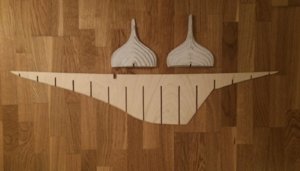
- Feb 2, 2020
Very nice! - static or sailing? Ted
Thanks! Static is my plan
Administrator

- Sep 17, 2020
hbn said: This is my third wooden scale boat, the previous two being kits from Corel. This one is a scratch built model of the J-class yacht Enterprise, winner on Shamrock in 1930, based on plans found online at http://rcsailing.net/forum/index.php?threads/1-28-scale-enterprise-1930.5781/ drawn by user Claudio D, original drawings from the 'America Cup Yacht Design -1851-1986' of F.Chevalier & J. Tagland. Claudio D’s blueprints scaled down to 1:48, to achieve a LOA of 800mm. The J-class yacht Enterprise was originally built for Harold van der Bilt and designed by Starling Burges, Enterprise was the first J to win the America's Cup in 1930. Original boat dimensions: LOA 38.7 m LWL 24.4 m Beam 6.7 m Draft 4.4 m Yard t.b.d. Year t.b.d. Build started in 2016 but layed dormant during some time Prints were glued on 3mm plywood, hand cut to shape. Construction layer of hull made of 1x10mmx1m pine. Construction layer of deck made of 1mm plywood. Hull and deck cladden in 0,6x5mmx1m mahogany. View attachment 130947 View attachment 130949 View attachment 130950 View attachment 130951 View attachment 130952 View attachment 130953 View attachment 130947 View attachment 130949 View attachment 130950 View attachment 130951 View attachment 130952 View attachment 130953 Click to expand...

- Sep 20, 2020
Uwek said: Hallo @hbn , we wish you all the BEST and a HAPPY BIRTHDAY Looking forward to see your progress on you project.... Click to expand...
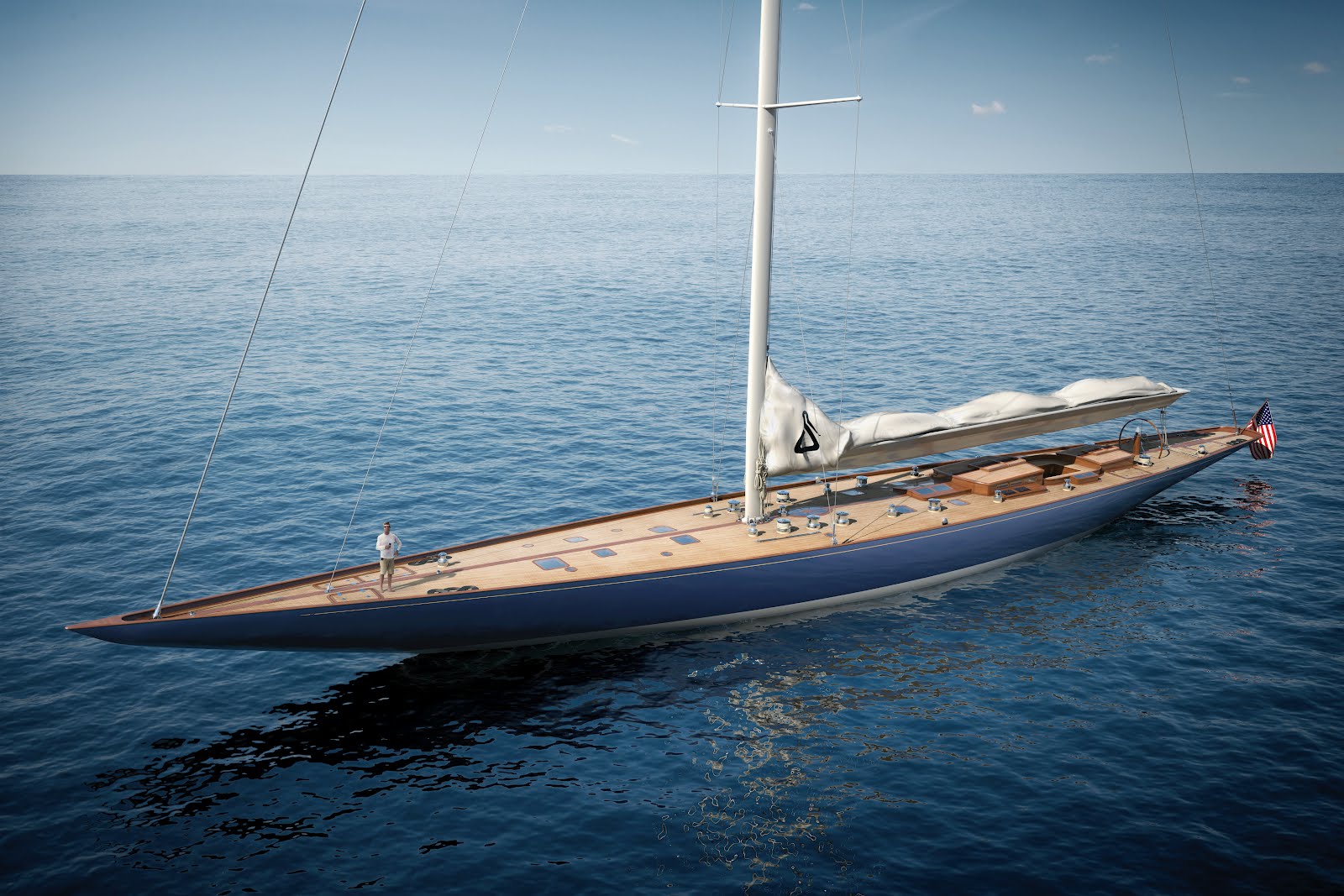
Enterprise was a 1930 yacht of the J Class [1] and successful defender of the 1930 America's Cup [6] for the New York Yacht Club. [4] It was ordered by a syndicate headed by Vice-Commodore Winthrop Aldrich, [4] designed by Starling Burgess, [2] and built by Herreshoff Manufacturing Company. [2]She was named Enterprise in honor of the six commissioned warships of the United States Navy to have ...
Enterprise. Originally built for Harold van der Bilt and designed by Starling Burges, Enterprise was the first J to win the America's Cup in 1930. She can be built in aluminium with an almost flush deck without deckhouses. Carbon hi-tech spars, a tall sail plan and an extensively optimised handicap will give ...
In answer to Lipton's challenge of 1929 the Americans designed four J-Class yachts as possible defenders. Enterprise, Whirlwind, Yankee and Weetamoe were launched within a month of each other; Weetamoe and Enterprise from the Herreshoff yard and Yankee and Whirlwind from Lawley & Son's yard in Bristol. Whirlwind, the second J, was the most ...
S/Y Enterprise. Enterprise is also the first J Class to be fitted with modern deck fittings, with nearly 23 winches on its deck plan. Victory is clear, as Enterprise won the Cup by 4-0 against Shamrock V. But this resounding victory did not allow it to escape deconstruction in 1935, just five years after its launch. Harold Vanderbilt, 1930 winner.
The J Class - so named because it was the letter allocated to its particular size by the Universal Rule to which the yachts were built (K and M Class yachts were, for example, shorter on the ...
The J-Class website points out that there are 10 unbuilt J designs from the 1930's, so the possibilities for more J-Class yachts are intriguing. Yachting World reported in May, 2003, that construction was underway on a yacht replicating the famous G.L Watson design Britannia. Photos showed a nearly completed hull at Solombala Shipyard, in ...
The J Class is one of several classes deriving from the Universal Rule for racing boats. The rule was established in 1903 and rates double-masted racers (classes A through H) and single-masted racers (classes I through S). From 1914 to 1937, the rule was used to determine eligibility for the Americas Cup.
In answer to Lipton's challenge of 1929 the Americans designed four J-Class yachts as possible defenders. Enterprise, Whirlwind, Yankee and Weetamoe were launched within a month of each other; Weetamoe and Enterprise from the Herreshoff yard and Yankee and Whirlwind from Lawley & Son's yard in Bristol. Enterprise was the first launched on 14 ...
The J Class Association was founded in 2000 to protect the interests of the Class, present and future, and organises an annual calendar of racing for these magnificent yachts. 2024 Calendar. 19-22 June.
1930. Lipton commissioned Charles Nicholson to design his contender. Shamrock V became the first J Class yacht. She was designed by Nicholson and built at the family yard in 1930, and before she crossed the Atlantic to attend the Cup she had notched up more than 700 sea miles (1,296km), won 15 out of the 22 races she had entered and had been ...
Shamrock V was built out of mahogany planking over steel frames and launched at the Camper & Nicholsons Gosport yard on 14th April 1930. She showed early promise on the British Regatta circuit winning 15 of 22 races and placing second in an additional four. She also underwent continuous upgrading with changes to her hull shape, rudder and ...
The tide turned fair again for the J Class only as recently as 1984, when American sailor Elizabeth Meyer bought the hulk of Endeavour and set about restoring her. "Elizabeth is very much the catalyst for the revival of the J Class with the renovation of Endeavour in 1984," Philip Lotz, commodore of the New York Yacht Club, said in 2017. "Her vision and inspiration… got restoration ...
Enterprise to Endeavour is an engrossing celebration of the massive and magnificent J-Class yachts. Ian Dear tells how only ten of these formidable yachts were ever built and subsequently raced for the America's Cup as well as for other trophies in American and British waters between 1930 and 1937. Yes, there have been bigger and faster yachts.
The Enterprise J Class Yacht. The J class yachts are some of the beloved of the America's Cup Wooden Sailboats because they represent an excellent compromise between seaworthiness and speed. As previously mentioned, the rules of The America's Cup favor the Americans because, during this era, the British yacht had to sail to the racing site ...
Enterprise to Endeavour. : Ian Dear. Sheridan House, Inc., 1999 - Sports & Recreation - 160 pages. Only ten J-Class yachts were ever built and they raced for the America's Cup and other trophies in British and American Waters for a mere eight seasons between 1930 and 1937. There have been many yachts that have been larger, and still others that ...
Or a replica anyway… The original Rainbow and Ranger J Class yachts both held their own, aptly defending the America's Cup. Harold Vanderbilt invested in J Class yachts to defend the Cup three times, with Enterprise in 1930, Rainbow in 1934, and Ranger in 1937. Although the originals didn't survive the cull for metal in WWII, replicas of both Rainbow and Ranger have since been built, which ...
Endeavour is a J-class yacht built for the 1934 America's Cup by Camper and Nicholson in Gosport, England.She was built for Thomas Sopwith who used his aviation design expertise to ensure the yacht was the most advanced of its day with a steel hull and mast. [1] She was 130-foot (40 m) and launched in 1934 and won many races in her first season including against the J's Velsheda and Shamrock V.
Yachts. In total nine J Class yachts are currently active, including three original surviving Js - Velsheda, Shamrock and Endeavour - and six replicas that have been built since 2003; Ranger, Rainbow, Hanuman, Lionheart, Topaz and Svea.
Enterprise to Endeavour: The J-class yachts. Hardcover - January 1, 1977. Raced for the America's Cup and other trophies between 1930 and 1937, only ten magnificent J-Class yachts were ever built. Though there have been many larger and faster vessels, no sailing class has ever gripped the public's imagination the way the J's did.
The. ENTERPRISE MODEL YACHT. (aka the America's Cup Sailboat Enterprise or just Enterprise Sailboat) was one of the best known American J Class yachts ever to sail. She was designed by the esteemed Starling Burgess and built in 1930 by Harold Vanderbilt- yes, THOSE Vanderbilts.
19 ft 8 in [2] (6.0 m) Draft. 14 ft 8 in [2] (4.47 m) Sail area. 7,540 sq.ft [2] (700.5 m 2) Shamrock V is a British J-class yacht. She was the first British yacht to be built to the new J-Class rule. She was commissioned by Sir Thomas Lipton for his fifth America's Cup challenge. Although refitted several times, Shamrock is the only original J ...
The J-class yacht Enterprise was originally built for Harold van der Bilt and designed by Starling Burges, Enterprise was the first J to win the America's Cup in 1930. Original boat dimensions: LOA 38.7 m LWL 24.4 m Beam 6.7 m Draft 4.4 m Yard t.b.d. Year t.b.d. Build started in 2016 but layed dormant during some time ...
- Print This Page
- Text Size
- Scroll To Top

Welcome to the MC Sailing Association
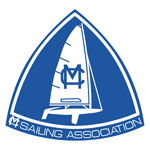
Upcoming Events
2024 regatta results.


“HISTORY OF THE SCOW” Film Proposal Woody Woodruff has been sailing scows a long time and is using his talents as a film producer to make a documentary film on scows: The Project Donate Here

© MC Sailing Association, Inc. 2024. All Rights Reserved.
presentation on respect

- business plan
- course work
- research paper

IMAGES
VIDEO
COMMENTS
J Boat. J Class. The J Class models are 1/16th scale hulls of the J Class yachts that sailed for the America´s Cup from 1930 through 1937 as well as the yachts that were converted to the J Class and competed with the America´s Cup yachts in club regattas. The models are the largest recognized class in the AMYA with hull lengths ranging from ...
The J class yachts are 1/16 scale versions of the original 1930's J-boats only, making it the largest of all the RC yachts. These classic yachts recreate the style of yachting's Golden Era, on a grand but affordable scale. Approx. 85-95" long. The largest class in the AMYA, the "J" boat. Class Website.
Feel free to contact me on [email protected] if you have any questions. You can also phone on 07969 538626 but I'm often out of the country and calling can be expensive.
J Class Radio sailors. Public group. ·. 5.0K members. Join group. This group enjoys building, sailing and racing 1/16th scale models of Americas Cup J Class boats.
1/16th scale AMYA J Class Model Yachts from the 1930's. San Francisco Model Yacht Clubs 125th anniversary. J Class Yachts For Sale (Sail) Home; Upcoming Events; Rules; AMYA J CLASS History; ... About the AMYA J Class. Learn more about the AMYA J Class. AMYA J Class Rules AMYA J Class Registration About the AMYA J Class. Official Rules for the ...
This is a quick overview of the building process that is needed to build a model J boat. Below is a list of most of the materials that were used. WOOD. 2 - 1"x8"x8' pine, aspen, bass or other suitable wood that can be cut into 5/32"x3/8" strips for hull and deck planking.
The J Class models are 1/16th scale hulls of the J Class yachts that sailed for the America's Cup from 1930 through 1937 as well as the yachts that were converted to the J Class and competed with the America's Cup yachts in club regattas. The models are the largest recognized class in the AMYA with hull lengths ranging from about 7 feet in ...
J Class RC Sailboats are over 100 inches long (9 feet) and weight over 100 lb. 10 foot tall masts (12 ft would be true scale). Beautiful sailing boats!
J Class Yachts; Liners and Model Cruises; Modern Yachts & Boats; ... Classic sailing boat (6) J class yacht (13) Manufacturers . AM (7) GN (10) OMH (2) Home > Display Ship Models > J Class Yacht Models J Class Yacht Models. Showing the single result. View Product. Sale! Pen Duick Model Yacht (Standard Range) - AM (AS053) ...
Premier Ship Models presents its exquisite J Class yacht model collection. Handcrafted with precision, these museum-quality replicas capture the elegance and power of these legendary racing yachts. ... Classic sailing boat (6) J class yacht (13) Manufacturers . AM (7) GN (10) OMH (2) Home > Display Ship Models > J Class Yacht Models J Class ...
RC Sailboat Kits, Radio Control Sailboats, Parts and fitting for the CR-914, EC12 Meter, Star 45, Santa Barbara and J Class boats . www.rcyachts.com. ... J Class Boat-Shamrock V. 1/16 (8'-10')Scale Replica of the 1930's America's Cup Class Yacht. View Page. RMG Sail Winches. High Performance sail control winches. View Page. Home;
Turk Model Boat Kits; Vanguard Wooden Ship Model Kits. View All Vanguard Wooden Ship Model Kits; Ship Model Kits; Ship's Boat Kits; WW2 Ships; Yankee Models (Multimedia) ... Endeavour J Class with Tools - Amati AM1700/10. The yacht Endeavour staked a claim on the America's Cup, winning the first two races. ...
J-Class RC yachts are huge. By far the largest of the RC sailboat classes. 100+ inches long and over 100 lb. 10 foot tall masts. This is a race in the 20...
The J Class groups specifically sail 1/16 scale models of America's Cup yachts that were, duh, "J Class" boats - boats from the 1930's exclusively before the America's Cup switched to 12 meters after WWII. The J boats are stunning. Ranger, Endevour, Shamrock, etc... are spectacular in their gorgeous lines. However, I grew up watching 12 meters.
Setting up and tuning your J Class model with Bermuda rig. Introduction. The Nottingham 48 and the 60 are well designed models which in a good state of trim should be elegant, rapid and predictable on the water and a very satisfying model to sail. The underwater profile will resist the weed that is becoming a feature of summer sailing and which ...
J-class yacht cruising the model boat pond in Vallensbæk, Denmark. This is the first time the current owner put it in the water. Other boats in this video:Gr...
J Class yachts Velsheda, Topaz and Svea downwind legs. The J Class is one of several classes deriving from the Universal Rule for racing boats. The rule was established in 1903 and rates double-masted racers (classes A through H) and single-masted racers (classes I through S). From 1914 to 1937, the rule was used to determine eligibility for ...
J Class Wooden Yacht Model Replica "Lionheart". 1937 America's Cup J Yacht Ranger Wooden Sailboat Model. The J-class yacht Ranger won the 1937 America's Cup, defeating 4-0 the Endeavour II of Britain, raced at Newport, Rhode Island. It would be the last time huge J-class yachts would race in the America's Cup. Vintage Photo Shamrock V ...
CPM Model Sailboats. J class rc sailboats, header content region, insert text, image or banner ads here, or just delete this text and leave this area blank. 1/25 (36") Scale Ameri
A J-Class yachts is elegant and speedy. As a model boat with genua you can afford this masterpiece of sailing style.Watch the video of the maiden voyage.
Originally built for Harold van der Bilt and designed by Starling Burges, Enterprise was the first J to win the America's Cup in 1930. She can be built in aluminium with an almost
The MC Sailing Association originally formed in Shreveport LA, 1971. Since then, the MC class has grown to be one of the top one-design sailboat racing classes in North America. The scow design maximizes speed yet provides unmatched stability. There are more than 113 active fleets nationwide. An original design by the Melges family in 1956, it ...
CPM Model Sailboats. J class rc sailboats, header content region, insert text, image or banner ads here, or just delete this text and leave this area blank. 1/25 (36") Scale Ameri